Tomato Seed Production Guide - Organic Seed Alliance
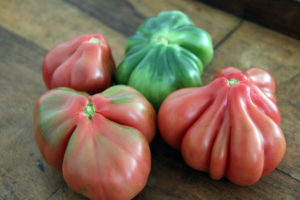
PUBLICATION DATE: February 12, 2021
AUTHORS: Laurie McKenzie and Jared Zystro, Organic Seed Alliance; Dan Egel, Purdue University
FUNDER: Tomato Organic Management and Improvement Project (TOMI) / The Organic Research and Extension Initiative, part of the USDA National Institute of Food and Agriculture. Award number 2014-51300-22267.

Table of Contents
- Tomato Background, Lifecycle, and Basic Biology
- Growing Tomato Seed
- Seed Storage
- Important Seedborne Diseases of Tomato Seed Crops
- References and Resources
Tomato Background, Lifecycle, and Basic Biology
The scientific name for tomato is Solanum lycopersicum (meaning “wolf peach”), although you will find older texts using the name Lycopersicon esculentum. Tomatoes are part of the Solanaceae or nightshade family, along with tomatillos, peppers, eggplants, potatoes, tobacco and others. The best available evidence on domestication points to tomatoes being derived from currant tomatoes (Solanum pimpinellifolium) in present day Peru. The cherry tomato-like ancestor was then taken to Mexico where much of the variation of the modern crop was developed.
Until recently, the origins and domestication of tomatoes were shrouded in mystery. The closest wild relatives were found in South America, but the center of diversity for cultivated forms was in Mexico some 2000 miles to the north. Recent molecular studies have shown that the closest wild relative is the current tomato (S. pimpinellifolium) distributed throughout Peru and Ecuador. S. pimpinellifolium and S. lycopersicum parted company some 78,000 years ago, long before humans were in the landscape in South America.
In the process of domestication, tomato underwent at least two genetic bottlenecks where genetic diversity was sequentially reduced compared to the wild species. The crop was introduced into Europe by the Spanish following their conquest of the Aztecs in 1521. The first tomatoes in Europe were known as “pomme d’amor” (love apple) in France, and “pomi d’oro” in Italy, the latter of which suggests that at least one of the early forms was a yellow- or orange-fruited type.
From Europe and Mexico, tomatoes spread around the world through maritime trade. In the process, the tomato has diversified into an astonishing number of heirloom types. Nearly all of these were developed without formal breeding, and hobby breeders and farmers today continue the tradition. Unlike other crops where genetic diversity seems to have been reduced through contemporary breeding efforts, recent genomics studies have revealed an increase in genetic diversity in modern, formally bred cultivars compared to heirlooms. The increase has been attributed to the use of wild relatives as sources of genetic variation for disease resistance and other traits. In the process of introgressing one or a few targeted genes, surrounding portions of the genome hitchhike into the new cultivar.
Modern tomatoes span several distinct market classes and colors. These classes include cherry types with round, grape, and pear shapes; saladette types that are similar to cherry types but larger; large, round slicer types; paste or plum types that have thick walls with high total solids, mainly used for processing; and heirloom types. The wild species, S. pimpinellifolium, is sometimes cultivated as a currant tomato and will readily cross with domesticated types. Tomato fruits can develop into a multitude of colors at maturity including red, orange, yellow, green, purple, pink, brown, black, various combinations of colors.
Most modern tomato varieties are almost entirely self-pollinating. This is facilitated by the floral structure in which a tight, fused, protective anther cone forms around the stigma, greatly reducing the incidence of natural cross-pollination. Most often the style is shorter than the anther cone, causing the stigmatic surface to remain inside the fused anther cone, which severely reduces the incidence of pollen sharing and transfer from one flower to another. In older standard and heirloom varieties, and often in cherry types, the degree of natural cross-pollination can be much higher than the occurrence in modern standard varieties. Older standard and heirloom varieties often have longer styles, pushing the stigma either flush with, or sometimes beyond, the tip of the anther cone. This arrangement facilitates higher rates of natural cross-pollination. The photo below illustrates this floral structure difference.
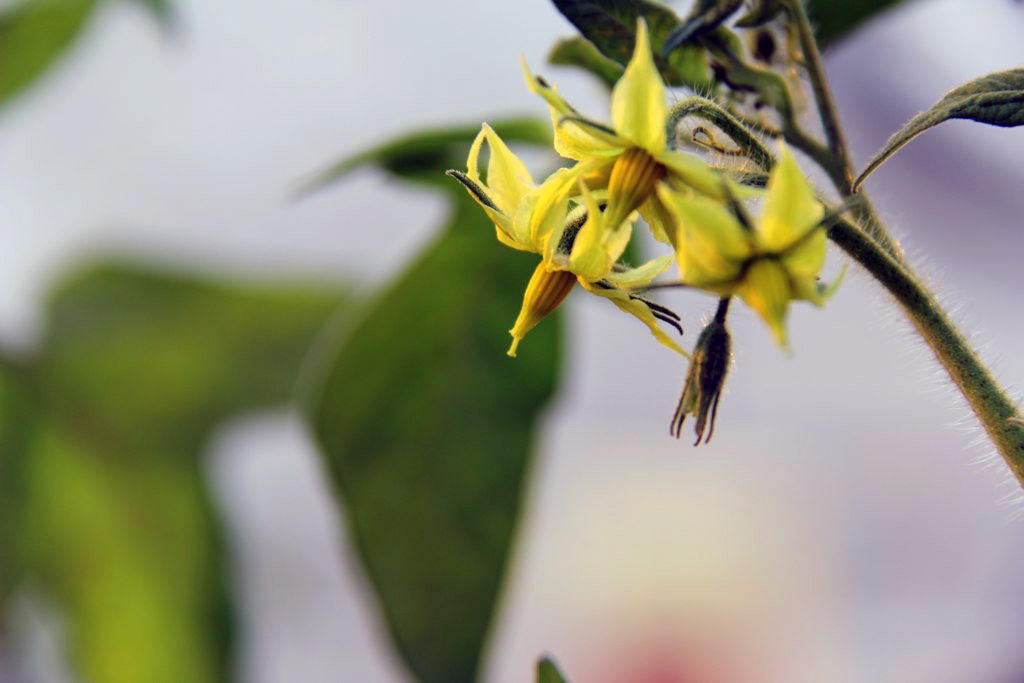
Bee and insect activity can also increase natural cross-pollination, which tends to be higher on organically managed land due to diverse cropping systems and absence of pesticides. Planting two older standard or heirloom varieties right next to each other may result in a natural cross, whereas hand pollination may be required to achieve a successful cross with modern varieties.
Growing Tomato Seed
Grown under optimal conditions, tomatoes generally have a 95 to 115 day lifecycle. The first flowers will appear and open seven to eight weeks after seeding and mature fruits will follow six to eight weeks later. Tomatoes have perfect flowers that contain both functional male and female parts. The male parts are known as the stamens and are each made up of an anther borne on a filament. The female parts are known as the pistils and are made up of a style and stigma positioned above an ovary. Flowering can occur over a time span of several weeks. Normally at least four to eight flowers are borne on each inflorescence, and a single tomato plant may produce as many as 20 or more inflorescences over a season.
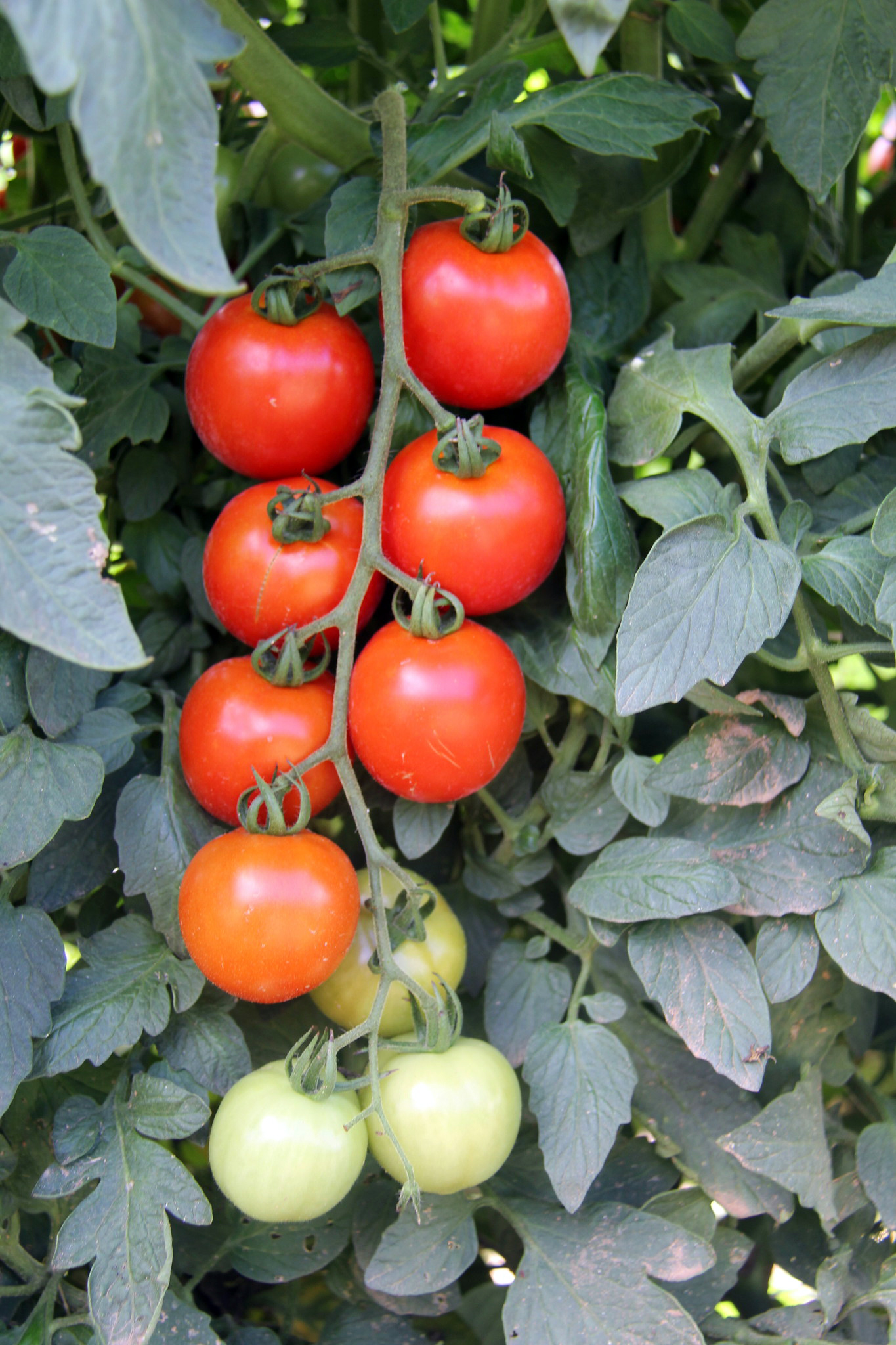
Climatic Requirements
Tomatoes prefer hot and fairly humid conditions for optimal growth. Daytime temperatures around 80-90°F and nighttime temperatures above 60°F are most ideal for tomato pollination and fertilization. However, it must be noted that too high of temperatures (above 90-95°F) can negatively affect both pollination and fertilization of tomatoes, resulting in inferior fruit and reduced seed set. Tomatoes are particularly vulnerable to cold damage if nighttime temperatures are regularly below 50-60°F. Lack of seed set in heat loving crops such as tomatoes may also result from the fact that pollination and fertilization are challenging under cool nighttime conditions. Pollen may not be produced, or if pollen reaches the female stigma and begins to grow a pollen tube during the day, it may abort and die when nighttime temperatures drop below 50-60°F (10°C). Moderate to high relative humidity conditions of 80-90% during the day and 65-75% during the night are best for pollination, fertilization, and fruit growth. Humidity helps the temperatures stay warm throughout the evening and nighttime when significant temperature drops can be common in non-humid regions and environments. Tomatoes can tolerate drier conditions and still produce, however, they may not yield quite as much or as high of quality fruit and seed.
Some tomato varieties can set fruit under limited pollination. This trait is referred to as parthenocarpy and it allows for fruit development under hot or cold conditions when pollen cannot function normally. Varieties with parthenocarpy may produce early season fruit with little to no seeds, while producing fruit with more abundant seeds in the later, and warmer, months of the growing season.
Genetic maintenance and population size – why population size matters
Maintaining an adequately sized population entails saving seed from enough plants to retain your variety’s genetic variability. Genetic variability refers to genetic differences among plants in the same variety. Although two tomato plants may look the same and produce functionally identical fruit, they may have differences in their genetic makeup that express as varying degrees of tolerance to various biotic (i.e., pests and diseases) and abiotic stresses (i.e., drought, salinity, heat).
One critical function of genetic variability is that it allows a variety to adapt to changing conditions. For example, imagine two different populations of a tomato variety, one large (100 plants), and one small (10 plants). Now imagine that the late blight attacks both populations. In the large population, despite the disease, five plants survive to produce fruit and thus seed, and in the small population, no plants survive. Why? The odds are better that in the larger population, a few plants will happen to have a gene that gives them resistance to late blight. In our example, as luck would have it, five plants in the large population had a gene that gave them resistance to late blight. If late blight strikes again next season, plants grown from the survivors’ seed will be more likely to endure the outbreak. In the small population, the odds that a few plants will have the gene for resistance to late blight are not as good; indeed, in our example, none of them had the gene, so none survived. The smaller population did not have enough genetic variability to contend with the disease. So, in larger populations, there is greater genetic variability, and it is more likely that, just by chance, some plants within the population will have a gene that can help them contend with new challenges.
Ideally you should save seed from more than one plant whenever possible. Although you may be able to maintain a tomato variety by saving seed from one or two plants each year (or every few years depending on how much seed you need and/or use), this strategy will decrease the amount of genetic variability in the variety and thus increase the risk of loss to stressors and/or disease in the future. Producing and saving seed from multiple plants will help to ensure that sufficient diversity is preserved for continued reliable and robust (future) production. Always save seeds from healthy, robust plants. Do not save seeds from diseased and/or failing plants.
Two critical factors should be considered in maintaining the genetic health, resiliency and integrity of a tomato variety during seed production: population size and isolation distance. Although tomatoes are primarily self-pollinating, cross pollination can occur. Depending on the type of tomatoes (different, same, or similar market classes) and the intended use of the seed produced, cross pollination can be more or less of an issue. If the seeds produced are primarily for home use and some cross pollination can be tolerated, then several types of tomatoes can be grown in close proximity to each other without much concern. On the other hand, if the seed produced is to be shared with others and/or sold commercially, cross pollination can be problematic. To ensure the varietal and genetic integrity of a variety, follow these recommended population sizes and isolation distances for the amount of space to maintain between different varieties and/or different market classes:
Isolation Requirements
Modern Tomato Varieties (varieties with round fruit and stigmas that are shorter than the anther cone):
Minimum distance for home use: 10 ft
Minimum distance for commercial production: 20 ft
Minimum population size for genetic maintenance: 10-20 plants
*If growing multiple tomato varieties or types use the greatest isolation distance
Heirloom or Potato Leaf Varieties (varieties with lobed fruit and stigmas that extend beyond the anther cone):
Minimum distance for home use: 40 ft
Minimum distance for commercial production: 160-320 ft
Minimum population size for genetic maintenance: 10-20 plants
*If growing multiple tomato varieties or types use the greatest isolation distance
Most commercially available tomatoes are self-pollinated and seed saved from their fruits will grow true to type. Although it is not botanically correct, these varieties are sometimes labeled as open-pollinated (OP) in seed catalogues and on websites. As tomatoes are mainly self pollinated they are not openly sharing pollen among and between flowers and plants like true open-pollinated crops. However, like true open-pollinated crops, seed saved from tomato varieties labeled as open-pollinated will grow true to type. Saving seed from a hybrid (F1) tomato variety will produce viable plants the following season, however, they will not grow true to type and will likely produce plants expressing a range of diversity and variation. Saving seeds from a hybrid tomato is not advisable unless you are intending to start a breeding project.
Selection Criteria
Agronomic Traits
Growth habit: Although tomato varieties are thought to be determinate, semi-determinate, and indeterminate, in actuality tomato variety growth habit can express on a continuum throughout the growing season. In general, indeterminate varieties grow continuously with three leaf nodes occurring between each inflorescence; determinate varieties express a finite amount of growth with only one leaf node between inflorescences. Semi-determinate varieties express intermediate growth with two leaf nodes between each inflorescence.
Plant stature: Tall plants are most common, dwarf varieties are less common.
Leaf shape: Heirloom types often express potato leaf shape whereas most modern standard varieties have regular shaped leaves. Potato leaf types commonly have exposed stigmas.
Canopy cover: Minimal leaf coverage can contribute to sunscald. However, minimal leaf coverage can also enhance color in purple types that have light responsive compounds in the skin.
Maturity: Maturity is related to the intended production environment. For example, early maturing varieties are needed in colder climates with short growing seasons.
Pedicel attachment: Fruit breaks off at the calyx in jointless pedicel types. In plants with jointed pedicels, fruit breaks off with a bit of stem. This is of particular significance for processing tomatoes where attached stems can puncture fruit and reduce quality.
Defensive Traits
Disease resistance: Some varieties have single gene resistance, also known as vertical resistance, for certain races of the following diseases: leaf mold, Septoria, late blight, early blight, Stemphylium, and verticillium and fusarium wilts. Dominant resistance to tobacco mosaic virus and nematode resistance is also available. Other forms of complex, polygenic (multi-gene) resistance, also known as horizontal resistance, exist and are extremely beneficial to robust breeding work. Wild tomato types are often used in breeding work as sources of disease resistance.
Drought, heat, salinity tolerance: Complex and polygenic, little is known about the specific components of abiotic stress tolerance. Selection for these complex traits needs to be conducted under stress conditions.
Fruit Quality
Fruit color: This trait involves the combination of skin and flesh color. Skin is either yellow or colorless and flesh is red, yellow, orange, green, or purple/brown. Color is an indication of the dominant compounds in the fruit, with lycopene dominant in red types, beta-carotene in orange types, delta-carotene in yellow types, and phytoene in yellowish-white or green types. There are several genes that control and contribute to flesh color in tomatoes. Modifying genes may cause gradations in expression and production of color compounds. The particular combination of skin and flesh color determine the color of fruit a tomato variety will produce. Although it is a bit simplified given that certain gene combinations and modifiers can alter color expression, here are the general combinations that produce the rainbow of tomatoes we see today:
- Red types have red flesh and yellow skin
- Pink types have red flesh and colorless skin
- Yellow types have yellow flesh and skin (colorless skin and yellow flesh results in cream to pale yellow fruits)
- Orange types have orange flesh and either yellow or colorless skin
- Green types have green flesh and either yellow or colorless skin
- Black and brown types have red/green flesh with yellow skin
- Indigo types have red, yellow, orange, and green flesh with purple skin
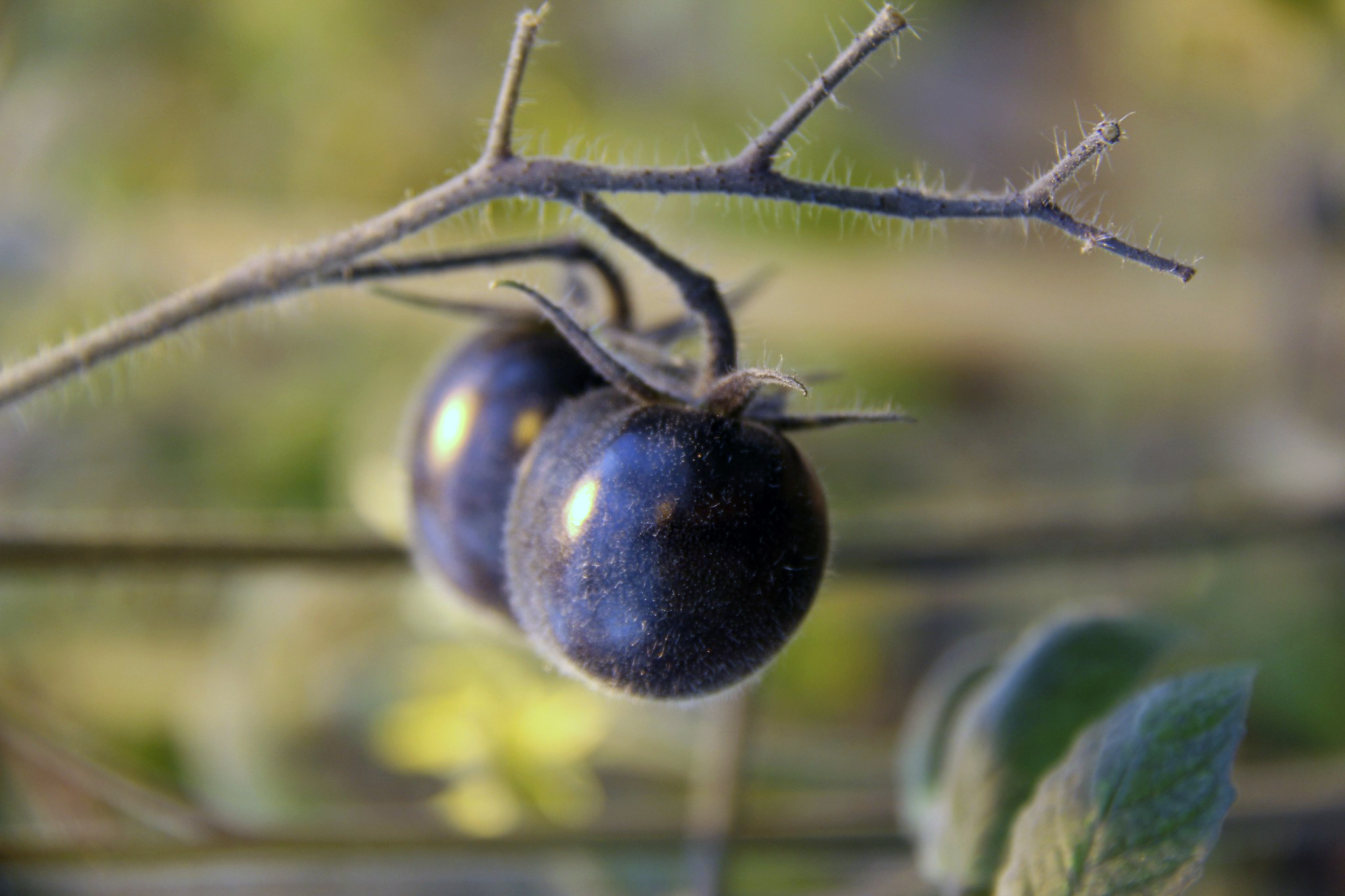
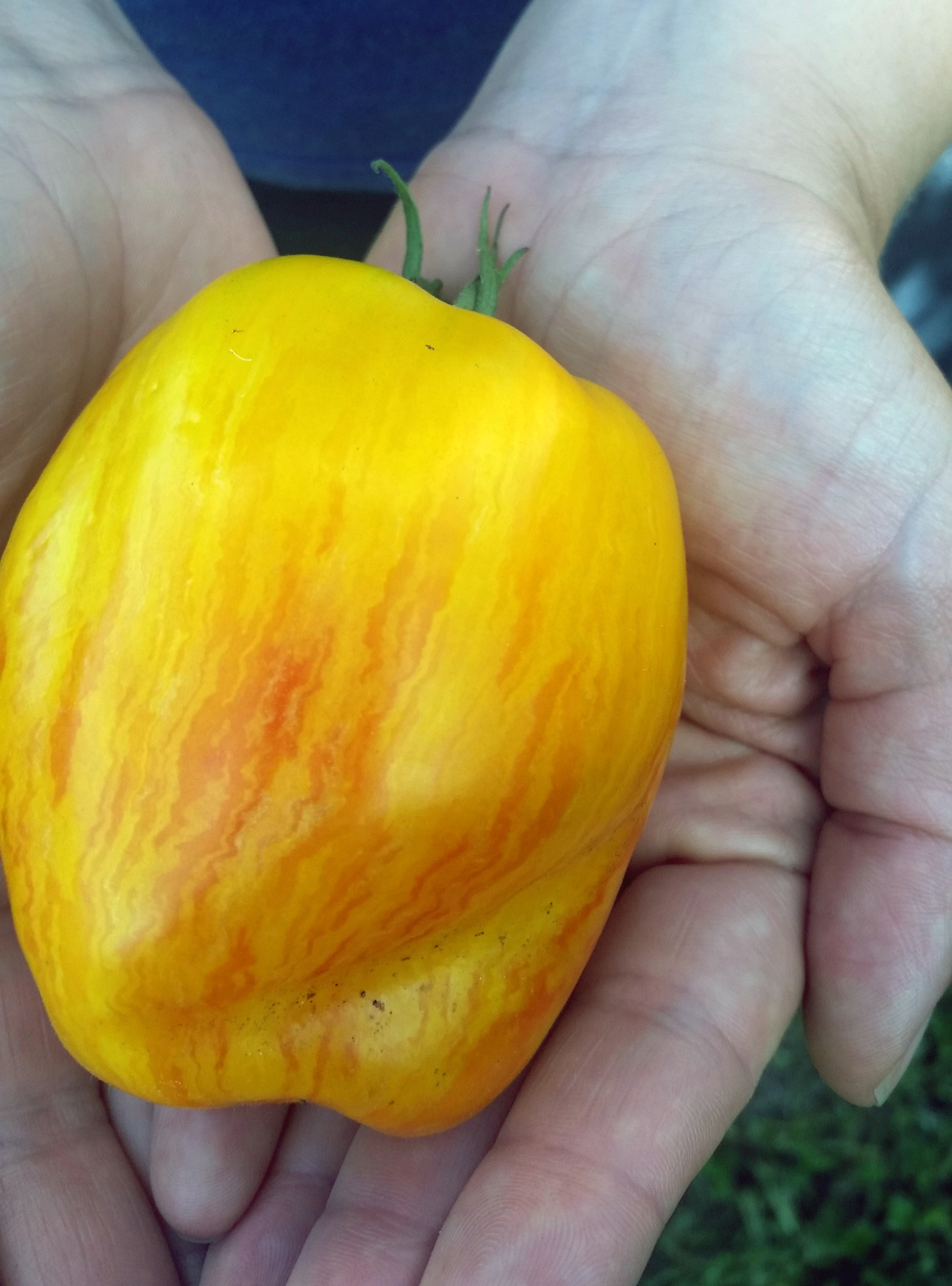
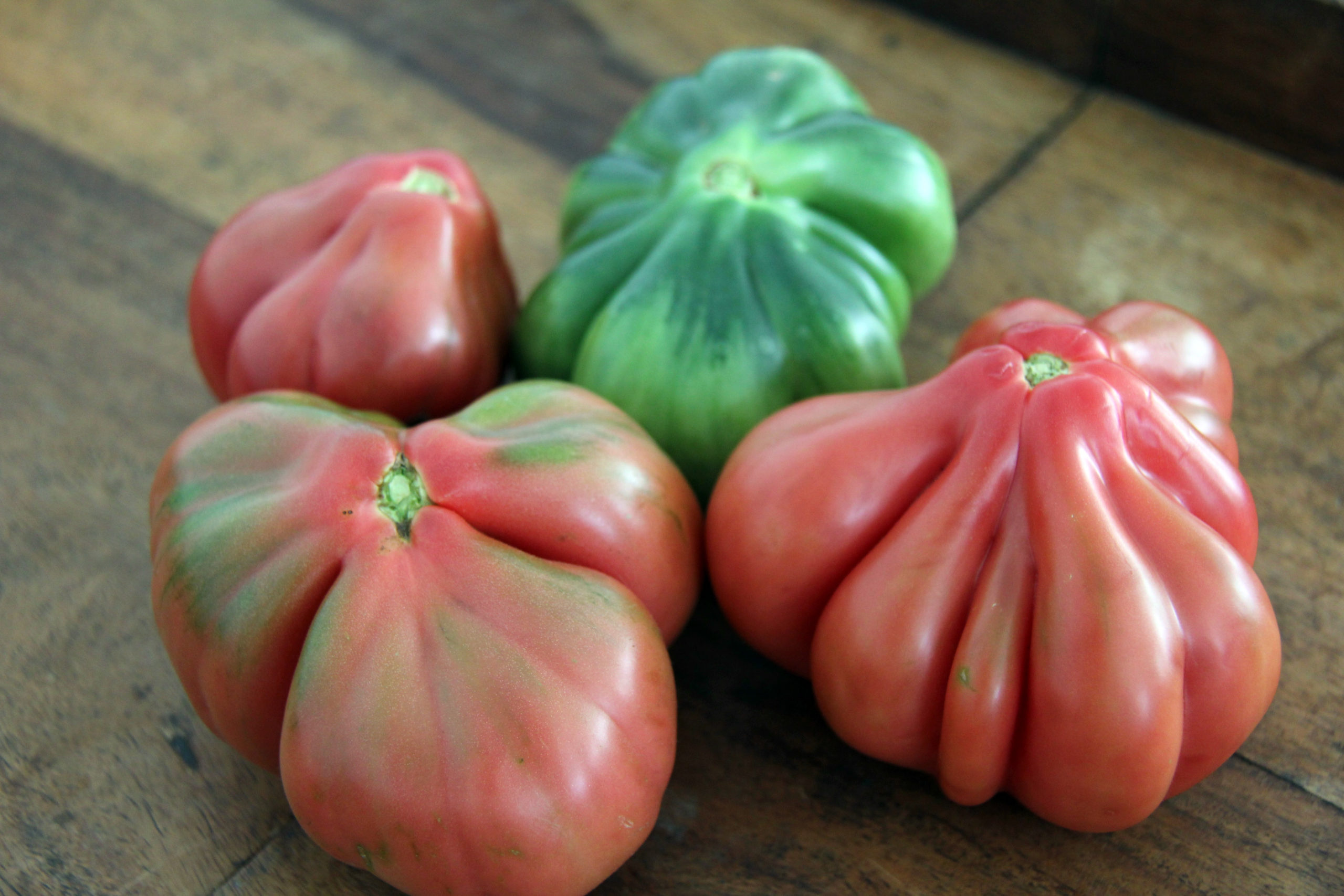
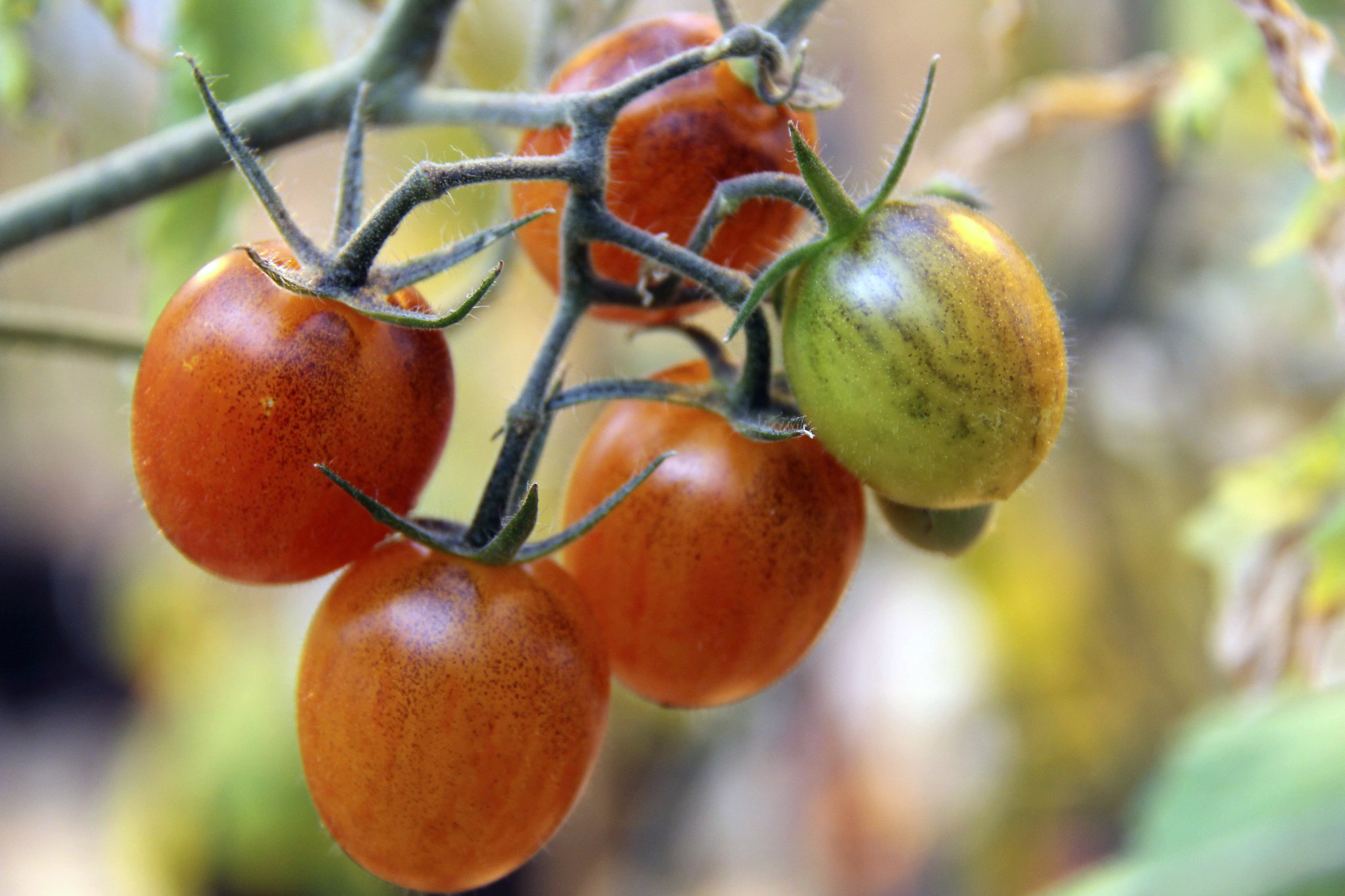
Fruit stripe: This trait refers to dark green radial stripes that occur opposite the locules. Stripes tend to fade as the fruit matures.
Green striping: This trait refers to irregular longitudinal green striping on the fruit. Stripes will either stay green or turn yellow at full maturity.
Skin texture: Most tomato varieties have smooth skin, but peachy, fuzzy textured skin also exists.
Flavor: Flavor is a complex and polygenic trait. Sugar-acid balance is important along with a number of flavor volatiles. Most of the sugars and organic acids reside in the gel, so locule size and number, as well as texture, are significant contributors to a tomato’s flavor profile.
Texture: Heirloom types are known for their “meaty” flesh texture. This is often a desirable trait in tomato breeding work.
Shape and size: Numerous fruit shapes and sizes are possible as a large diversity exists in tomato germplasm. Your market will likely be the largest determining factor in what size and shape is most desirable.
Fruit ripening: Green shoulder types have dark green shoulders when immature whereas fruit of uniform ripening types are entirely light green when immature. Green shoulder types have recently been associated with superior flavor compared to uniform ripening types. Uniform ripening types are associated to some extent with crack resistance and are desirable for paste tomatoes.
Yield: Although it is tempting to make selections for higher yield, selecting directly for yield is seldom highly effective. Yield is strongly influenced by environmental factors and cultural practice. While it is important to keep productivity in mind when deciding which plant to save seed from, consider the component qualities and characteristics that contribute to robust yields as well. This may mean placing emphasis on traits such as disease resistance, timing of maturity, growth habit, concentration of fruit set, resistance to cracking, and other factors that contribute to a high percentage of quality, marketable fruit rather than focusing solely on the relative abundance of fruit. Strive to always save seed from the most robust, healthy, productive plants.
Roguing
To “rogue” is to remove inferior or atypical plants. Essentially, roguing involves walking through your planting and pulling out the plants that you don’t want to reproduce. Roguing helps eliminate the ill effects of accidental crosses that may have occurred in a previous generation, accidental mixing of home-saved seeds, or genetic mutations. If you do not rogue, your variety will become more variable and “deteriorate”, showing more and more undesirable traits season after season. Some helpful guidelines for roguing include:
Rogue more than once. Roguing varieties at more than one point in the season is often the best strategy. For example, at the beginning of the season, you may remove tomato seedlings that were the slowest to grow. Later in the season, you may remove plants that have off-type fruit. Still later, you may remove plants that appear to be the most affected by disease.
Consider variable conditions in the field. Plants that are in a poorer part of your field may perform poorly in comparison to their neighbors not due to inferior genetics but because they have had proportionately less sun, water, soil nutrients, etc. Conversely, plants that are in the best part of your field, or that are on the edge of an otherwise uniform field, may perform better not due to their superior genetics, but because they have had the advantage of more sun, space, soil nutrients, etc.
Maintain population size. When considering how many plants to rogue, be sure to keep enough plants to maintain genetic variability, stability, and health of the variety.
Harvesting and Cleaning
When to harvest and when to extract seed
Tomato seed will be fully mature when the fruit is ready to eat. Fruits may be left on the vine to ripen past the eating stage until they soften a bit but take care not to let fruits get rotten or moldy before harvesting for seed.
When the tomato fruits are ready to eat, you have two options for seed harvest: either (1) promptly harvest the tomatoes, extract the seeds, and eat the flesh or (2) allow the fruits to further ripen and soften a bit on the vine to maximize seed quality and quantity. Use the first option if eating perfectly ripe tomatoes is more important to you than extracting the greatest yield of fully mature seeds. If maximum seed yield and quality is the primary goal, harvest fruits when they are starting to soften but before they show signs of serious decay.
Cleaning Methods
The key to cleaning tomato seeds is removing the gel and placental tissue that clings to and protects the seeds. This gel has germination-inhibiting compounds that must be removed to prevent low germination rates. Physical rubbing and scrubbing and/or fermentation are the two ways to rid tomato seeds of this protective gel. Fermentation is recommended as it seems to be a more effective and less time consuming method.
Fermentation
Fermentation breaks down the placental tissue and protective gel, allowing them to be easily rinsed off the seeds through decanting. Fermentation also has the power to reduce and potentially destroy some destructive diseases. However, note that fermentation works best to reduce any disease inoculum that is on the seed coat but is not effective at reducing or destroying disease inoculum that has penetrated into the seed.
- For small lots or few fruits, cut fruits in halves or quarters and squeeze or scoop out seeds and placental gel. For large lots, smash whole fruits into a slurry. This can be accomplished by placing them in a bucket or trash can and mixing with a heavy duty paint stirrer attached to an electric drill. Add water to the seed and pulp slurry only if the mixture is too thick to stir.
- Place container of slurry in a warm location, ideally between 70-85°F. Depending on temperature and seed variety, the fermentation process can take anywhere from 48 to 72 hours. Cover loosely with a lid if fruit flies could be an issue.
- Stir the fermenting slurry two or three times a day to aerate it and facilitate even fermentation. A small amount of white mold may appear on top; it is not harmful and can be stirred back in.
- Closely monitor the seed for sprouting. Although damage may begin earlier, sprouting is a sure sign that the seed has soaked too long, and that damage has occurred. Experts disagree on the best method to determine when fermentation is complete. Some consider the process finished when the mixture stops bubbling or when the seeds have all sunk to the bottom and the pulp is left floating on the top. Others stop when a thick layer of white mold completely covers the surface of the mixture. Still others test for doneness by regularly removing a sample of the fermenting seeds, rinsing them in a strainer, and feeling them (no longer slippery). If the gel around the seeds is completely gone, they consider the process finished. People have had success using all of these methods. Experiment to find the method that works best for you.
- Once fermentation is complete it is time to decant, rinse, and dry the seeds.
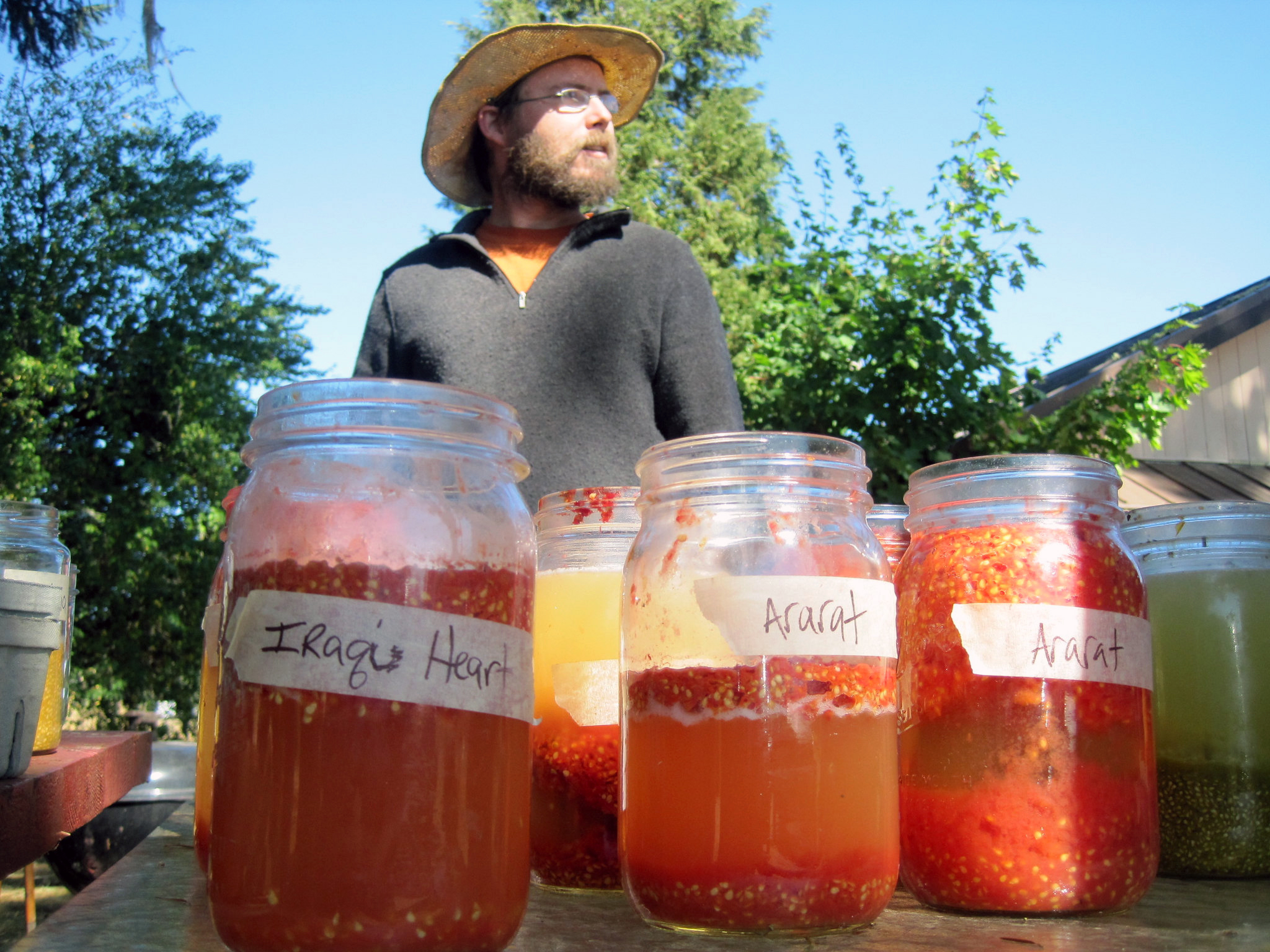
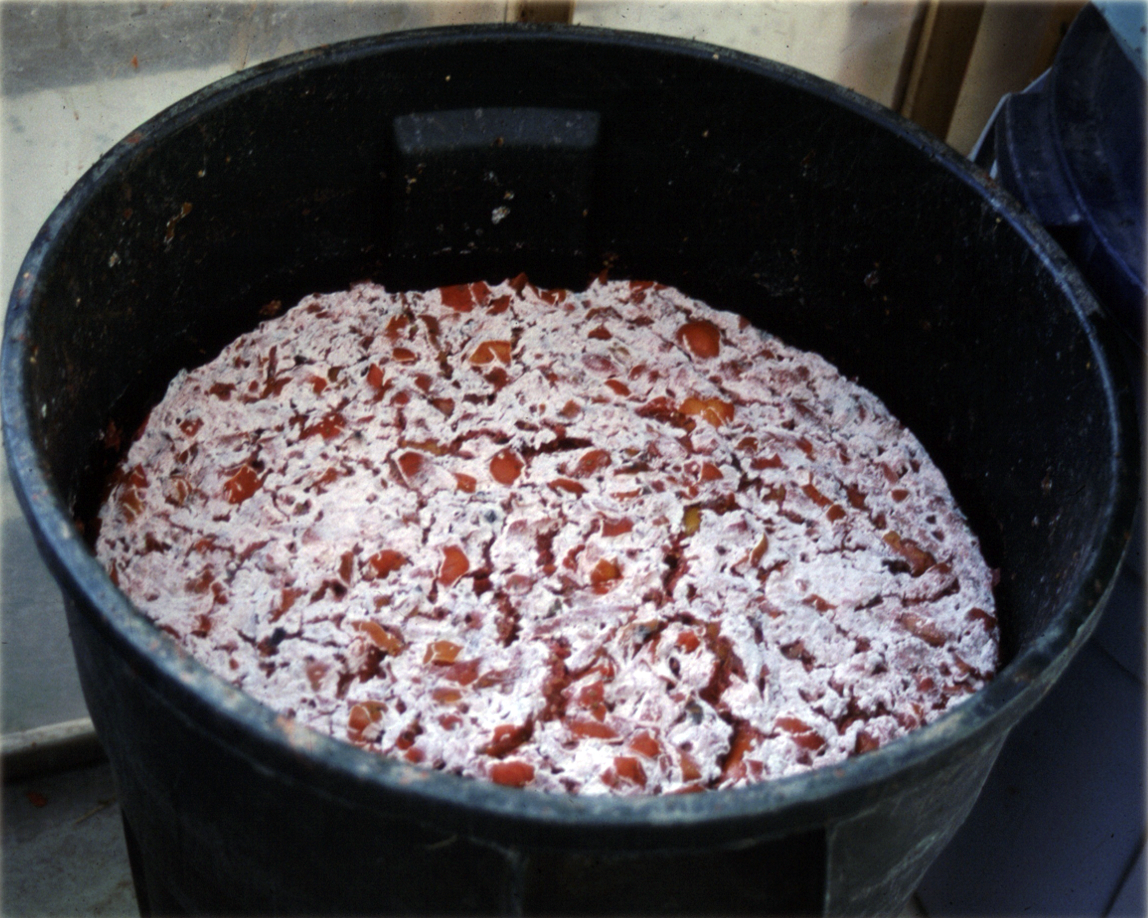
Decanting and Rinsing
The process of decanting uses water to separate pulp, debris and lightweight (less-viable) seed from good, heavy seed. Place fermented seed slurry in a container that can hold at least 5-10 times the volume of the slurry itself.
- Add water to fermented slurry and stir the mixture. A good general guideline is to have about 1 part seeds and pulp to 4 parts water. Allow mixture to settle, the seeds will sink and the pulp and tissue will float to the top of your container. Pour off the floating pulp and debris, keeping seeds in the container. Since tomato seeds are small and fairly lightweight, good mature seeds can become stuck to air bubbles and remain floating on top. In these cases, gently push the seeds down with your hands to break the surface tension and release the seeds. Pour the top layer of pulp, debris, and lighter, less viable seed off the top.
- Add water again and repeat the process, with each iteration there will be less and less pulp and debris. Generally it will take 3 to 6 times before the water runs clear and you are left with clean seed in the bottom of the container.
- After decanting, pour remaining water and clean seed into a strainer or onto a screen for final rising.
- Rinse seeds free of any remaining pulp and debris by spraying them with pressurized water.
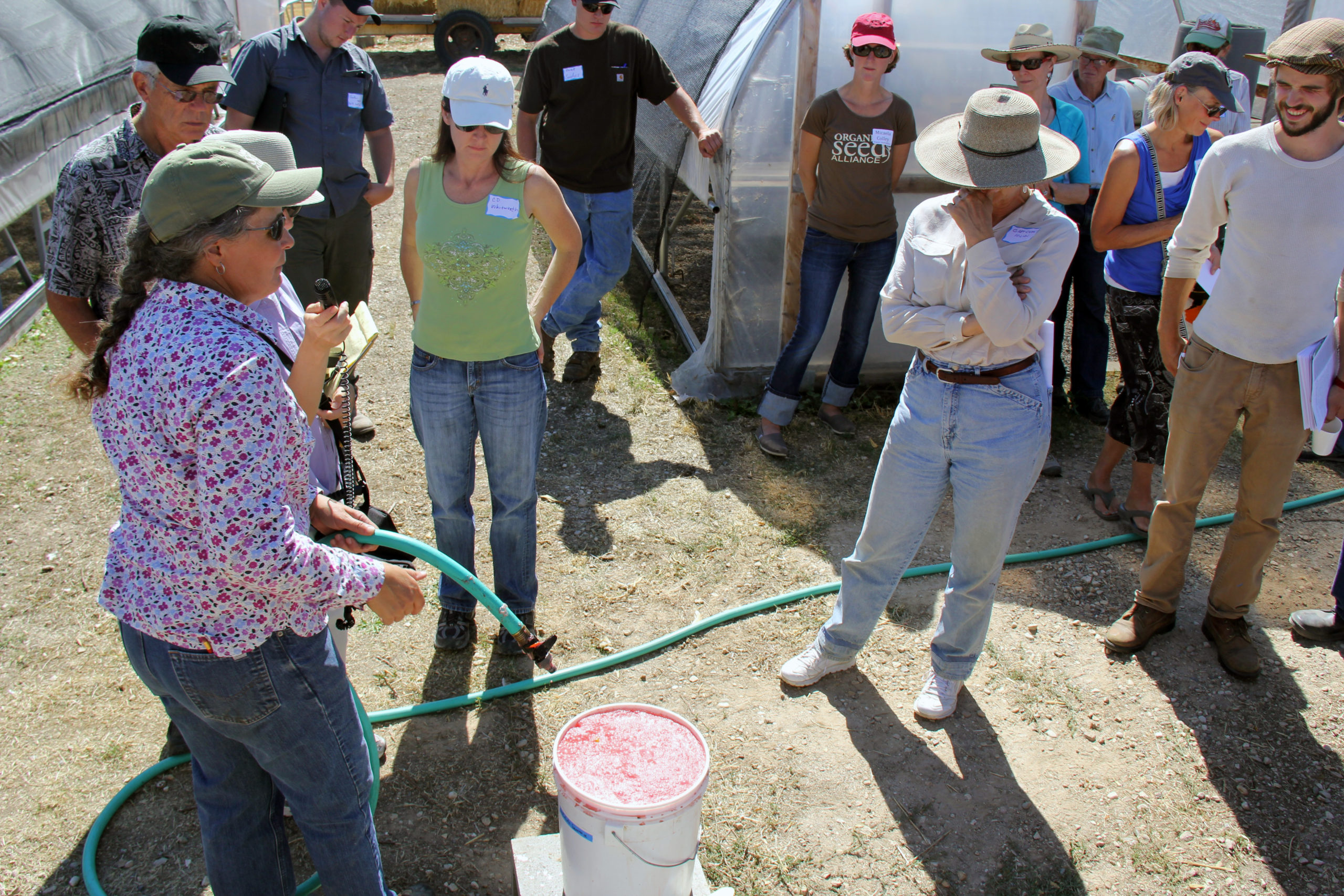
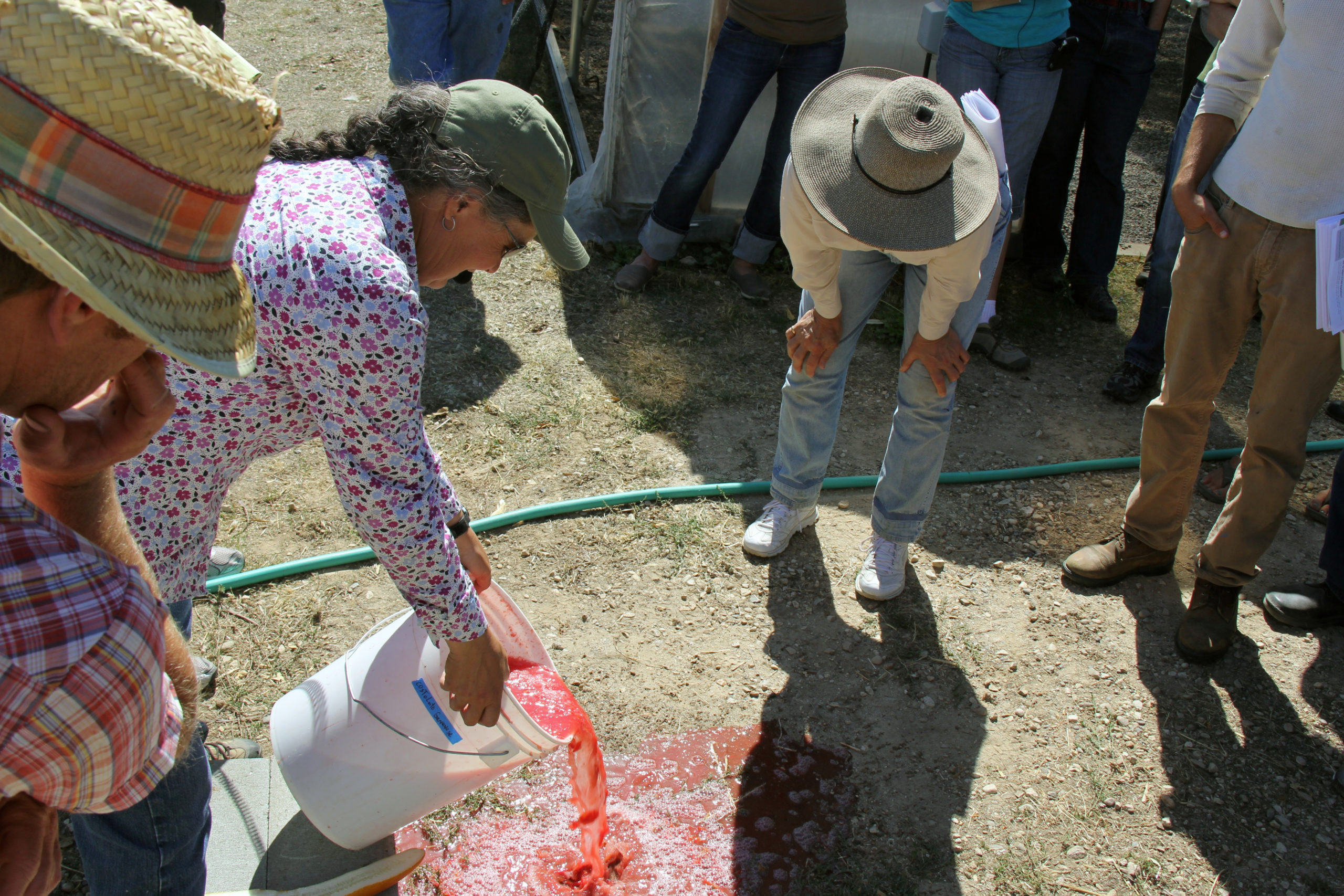
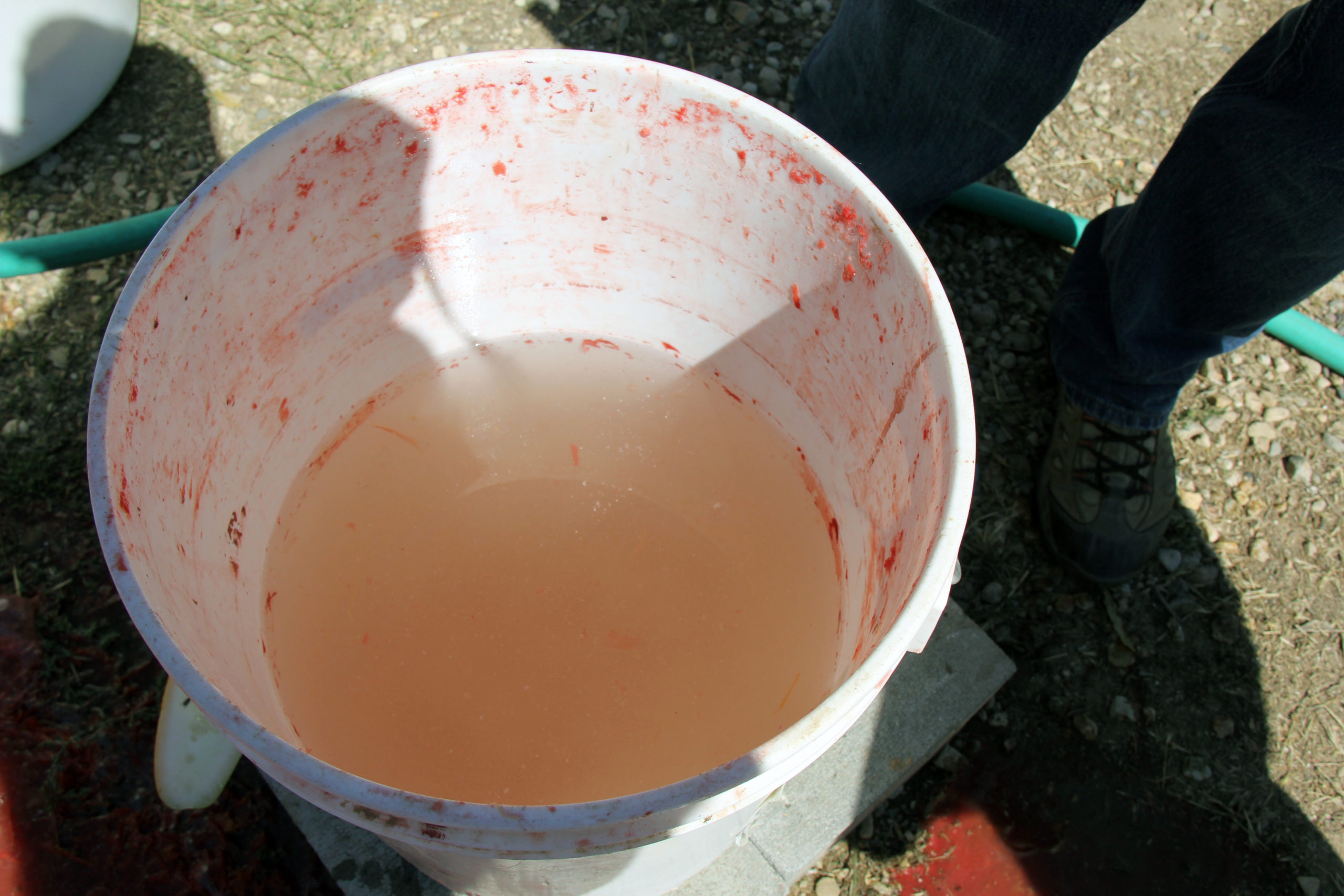
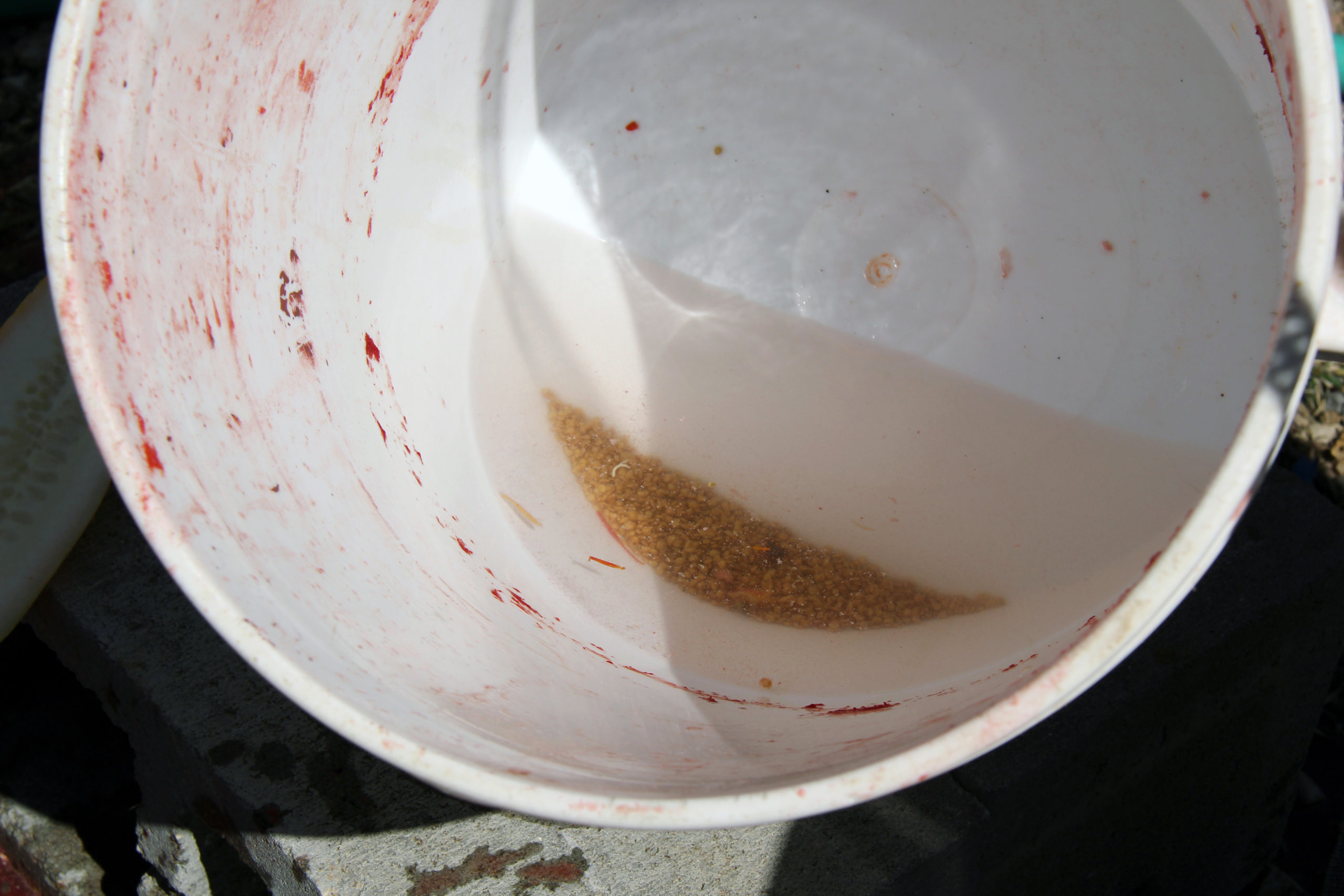
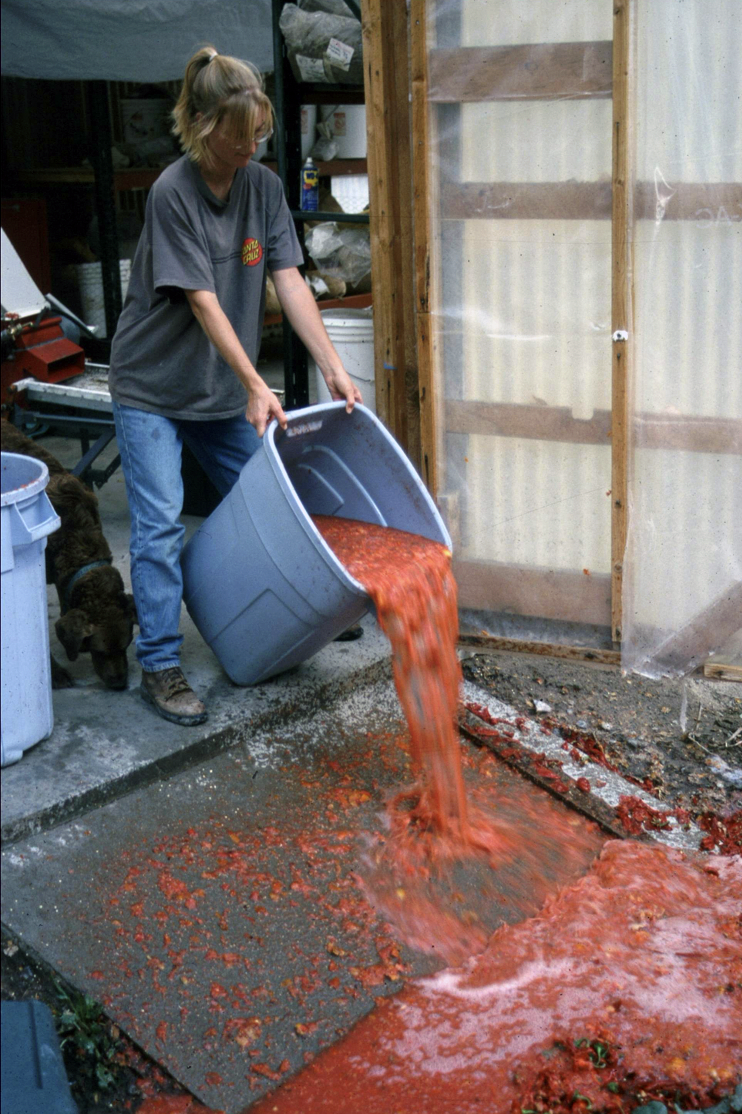
Screening and Rinsing (non-fermentation method)
The basic elements necessary for screening are: (1) something with small holes in it, such as a colander, strainer, or screen, (2) pressurized water, and (3) hands for rubbing. Rinsing setups can vary according to your scale and how thorough of a rinse is necessary. One drawback to relying solely on rinsing for cleaning tomato seed is that it does not remove lightweight, non-viable seeds. Below are two common methods:
- Place seeds and pulp in a strainer. Put the strainer under running water. Rub and rinse until the seeds are clean and free of pulp, debris, and placental gel.
- Use two framed screens, one on top of the other. The top screen should have holes just large enough to allow the seeds to fall through while retaining large pieces of pulp on top. The screen below should have holes just small enough to retain the seeds on top while allowing small pieces of pulp to fall through. Place seed and pulp slurry on the top screen and break up the material by rubbing and spraying with water. Once the majority of the seeds have fallen through the first screen, remove this screen and spray and rub the material on the bottom screen until only seed remains.
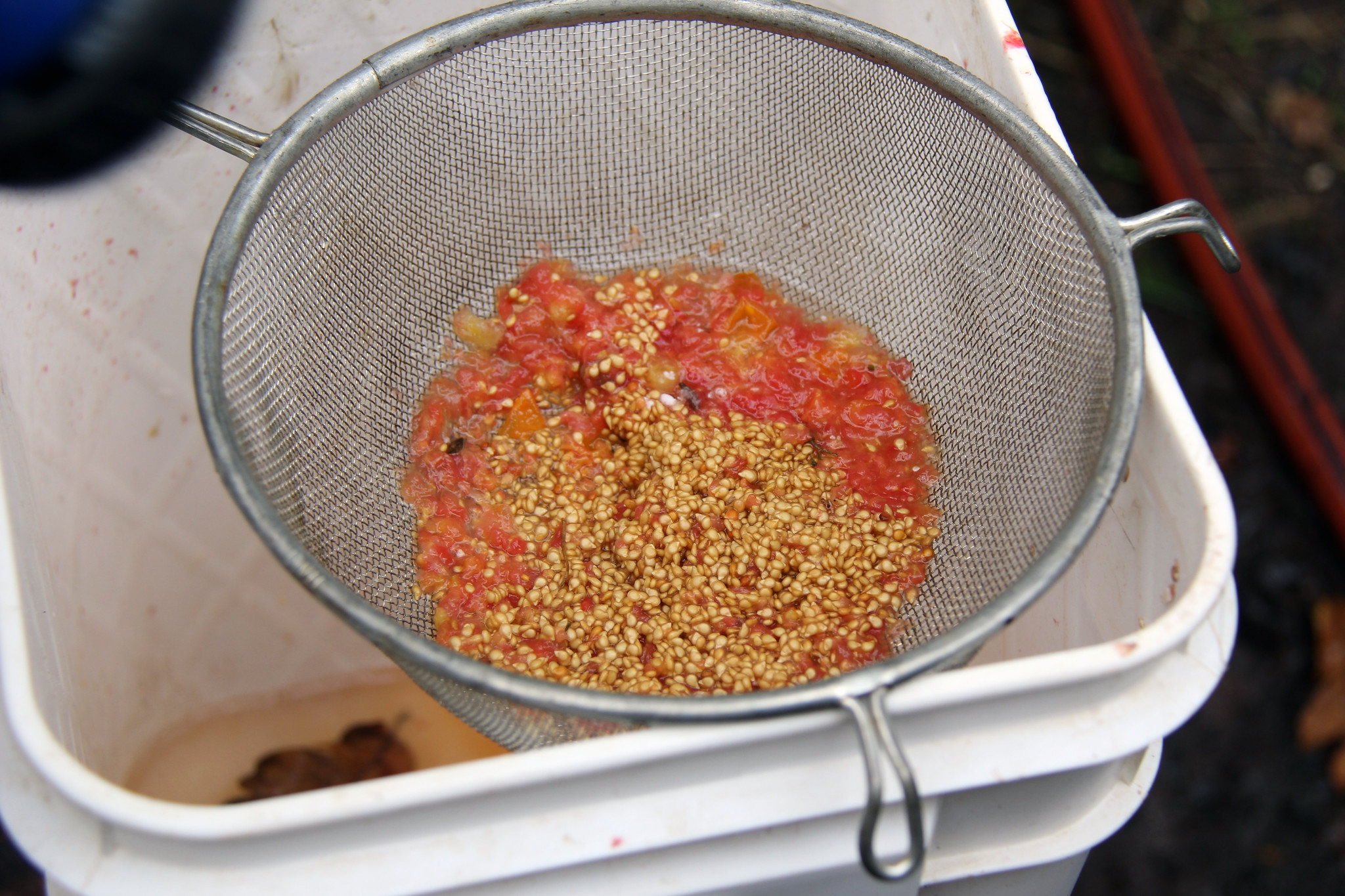
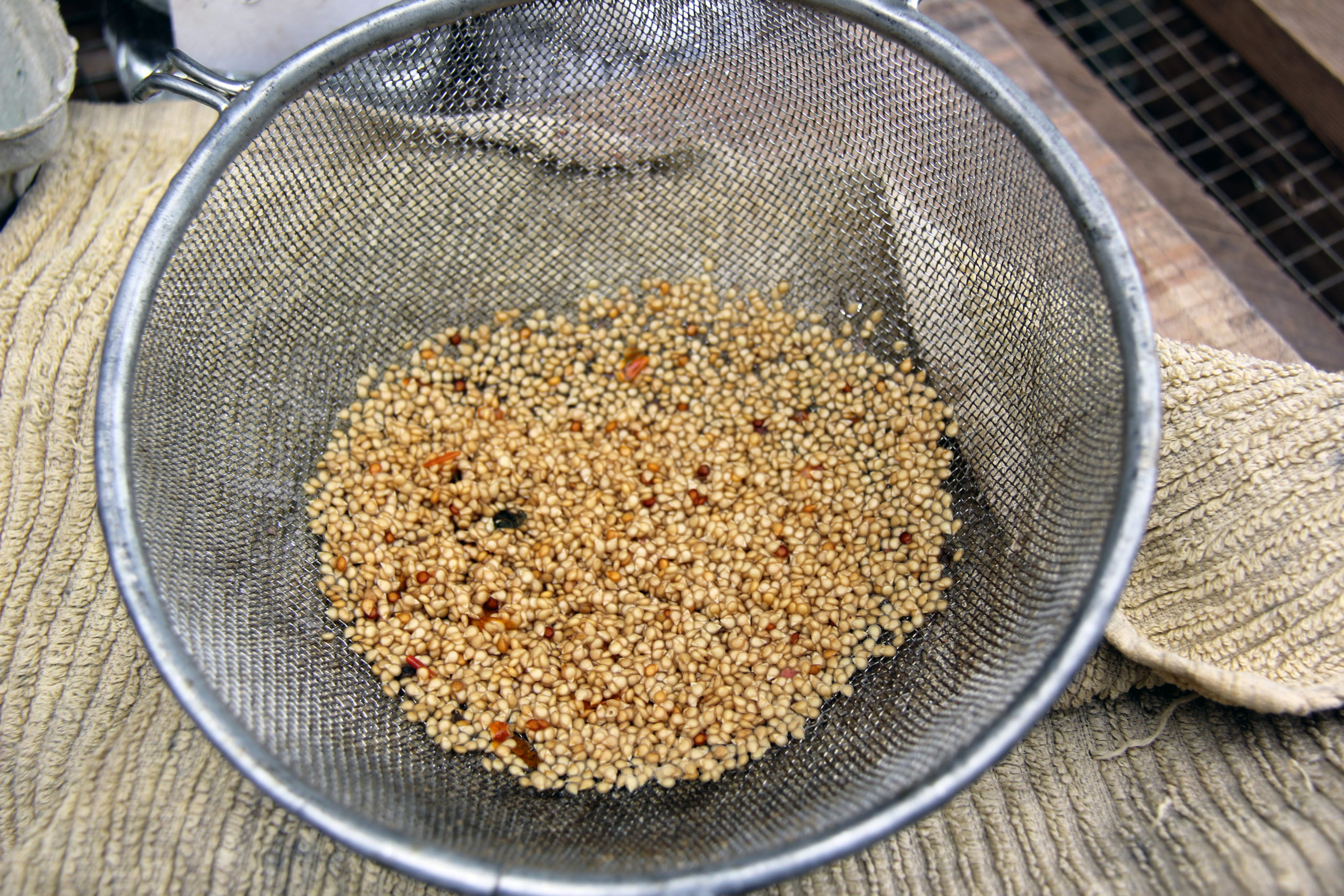
Drying Seeds
To reduce the risk of seeds becoming rotten or vulnerable to disease, seeds should be dried as quickly as possible. The ideal place for drying seeds is somewhere that is warm, dry, and has good airflow. Greenhouses, countertops, and desk tops are all good places to dry seed. Box, round, and standing fans are all helpful for maximizing and directing airflow over the drying seeds.
Spread seeds out in a very thin layer (one seed thick if possible) onto a screen, piece of plywood, sheet pan, or any hard, non-stick surface. Avoid using paper towels, newspaper, cardboard, or cloth because wet seeds will tend to stick to the surface, making them difficult to remove. Wet tomato seeds tend to clump; repeated stirring and physically breaking up the clumps every 15 minutes for the first hour or two (less often thereafter if needed) will encourage quick drying and seeds that are easily separated when fully dry. Keep in mind that seeds should not reach temperatures over 95°F (35°C).
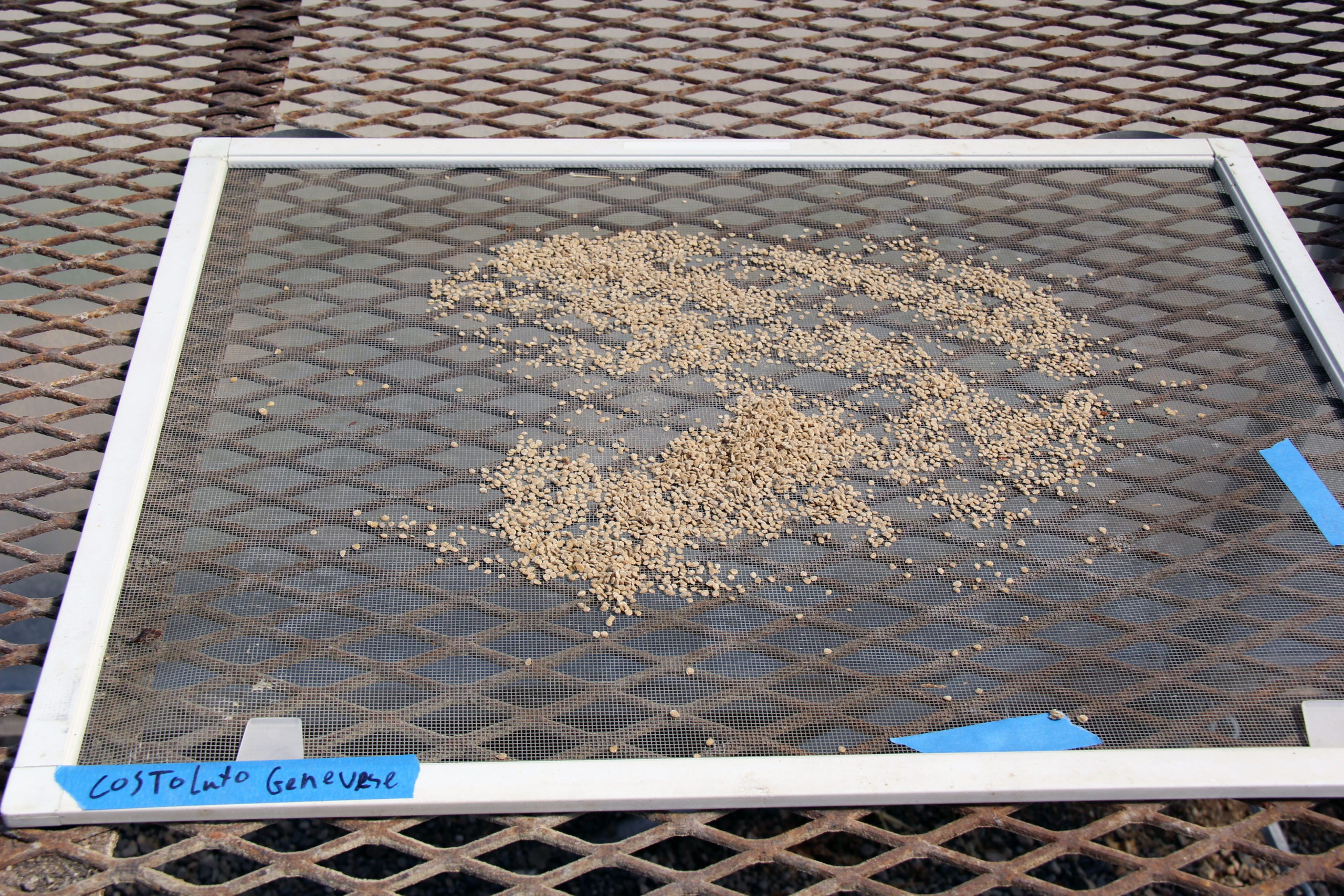
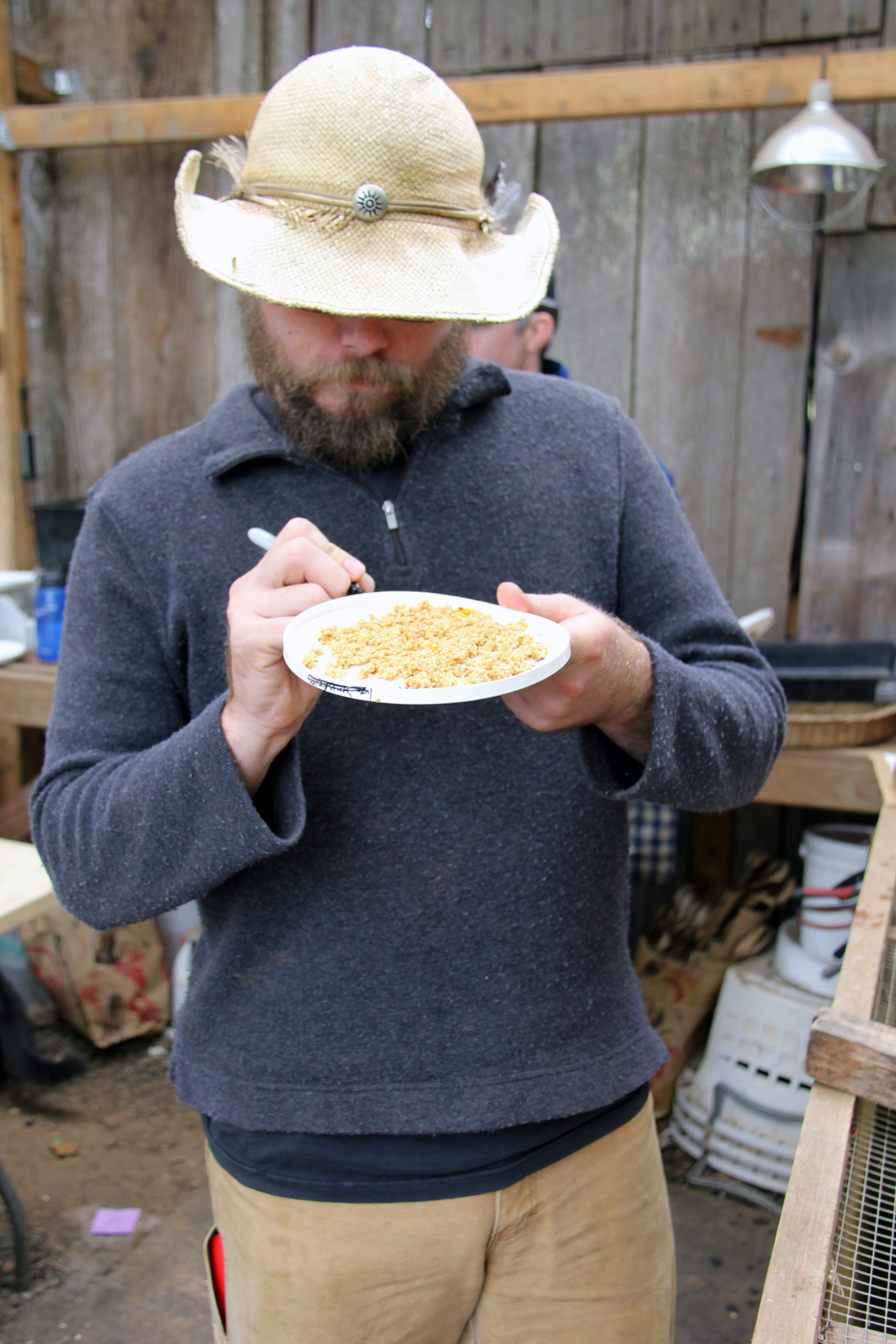
Seed Storage
Know how to protect your seed harvest and keep it viable
To maximize the life of your seed, keep it cool and dry, and protect it from insects and rodents. Seed needs to be kept cool and dry because inside every seed is a plant embryo living on the seed’s food stores; when the embryo uses up all of its food, it dies and the seed will not germinate. To prolong the life of a seed, then, you must slow down the rate at which the embryo goes through its food. You can do this by keeping the seed cool and dry. Another reason to keep your seed cool and dry is that cool, dry seed is less vulnerable to attack from bacteria, fungi, and some insects. A general rule of thumb for long term storage is that the combined humidity (in percent) and temperature (in Fahrenheit) should sum to 100 or less. Seeds may be stored in the freezer but should be packed to prevent frost accumulation inside the container and freezers with an automatic defrost cycle should be avoided.
Seed can be an excellent source of nourishment for rodents and many insects. Therefore, where insects and rodents are a concern, you will need to protect your seeds by storing them in thick plastic, glass, or metal. In particular, tomato seeds are especially attractive to mice and Indian Meal Moths.
For more information on seed storage, germination testing, and seed production of specific crops please visit the Organic Seed Alliance website (www.seedalliance.org).
Important Seedborne Diseases of Tomato Seed Crops
Hot Water Treatment
Tomato seeds infected by many superficial seedborne diseases can be effectively remediated by hot water treatment. Hot water treatment for tomato seeds requires two hot water baths with accurate temperature controls, as well as two submersible pumps or other ways to circulate the water in the baths, and screen or mesh bags to hold the seed. Tomato seed hot water treatment is a three step process:
- Preheat the bag of seeds by placing it in the first water bath at 100°F (38°C) for 10 minutes. Make sure the bag or bags are not overfilled, as the water must be able to circulate freely through the seeds.
- Transfer the bag of seed to the second water bath, at 122°F (50°C) for 25 minutes. Make sure that there is enough water so that the temperature does not drop very much when the seeds are added to the bath.
- Remove and rinse the seeds with cool water immediately. Spread out the seeds to dry. (see the Drying Seeds section above for recommendations)
Hot water treatment can reduce both the germination and longevity of treated seed. For that reason, good practices are to treat immediately before planting, only treat as much seed as is needed for planting, and retest the germination to determine if overplanting is needed to get the required seedling populations.
For more details on hot water treatment, see PennState Extension’s online publication here: https://extension.psu.edu/hot-water-treatment-for-tomato-and-pepper-seeds.
Bacterial Diseases
Bacterial canker is caused by the bacteria Clavibacter michiganensis. It can also survive on tomato debris and on alternate hosts, primarily in the Solanaceae family. It grows most rapidly in moderate temperatures, with the optimal temperature for disease development being around 82°F (28°C). Symptoms begin as yellowing and dying of leaves, and streaking on the stem and petioles, which develop into open cankers. Plant-to-plant disease transmission can occur through rain splash carrying bacteria from open cankers. Cultural practices to reduce the spread of bacterial canker include active scouting and removal of any diseased plants, avoiding water-based transmission by refraining from overhead irrigation, not handling tomatoes during wet conditions, and practicing rotations of at least four years between crops in the Solanaceae family. Infected seed can be effectively treated by hot water treatment.
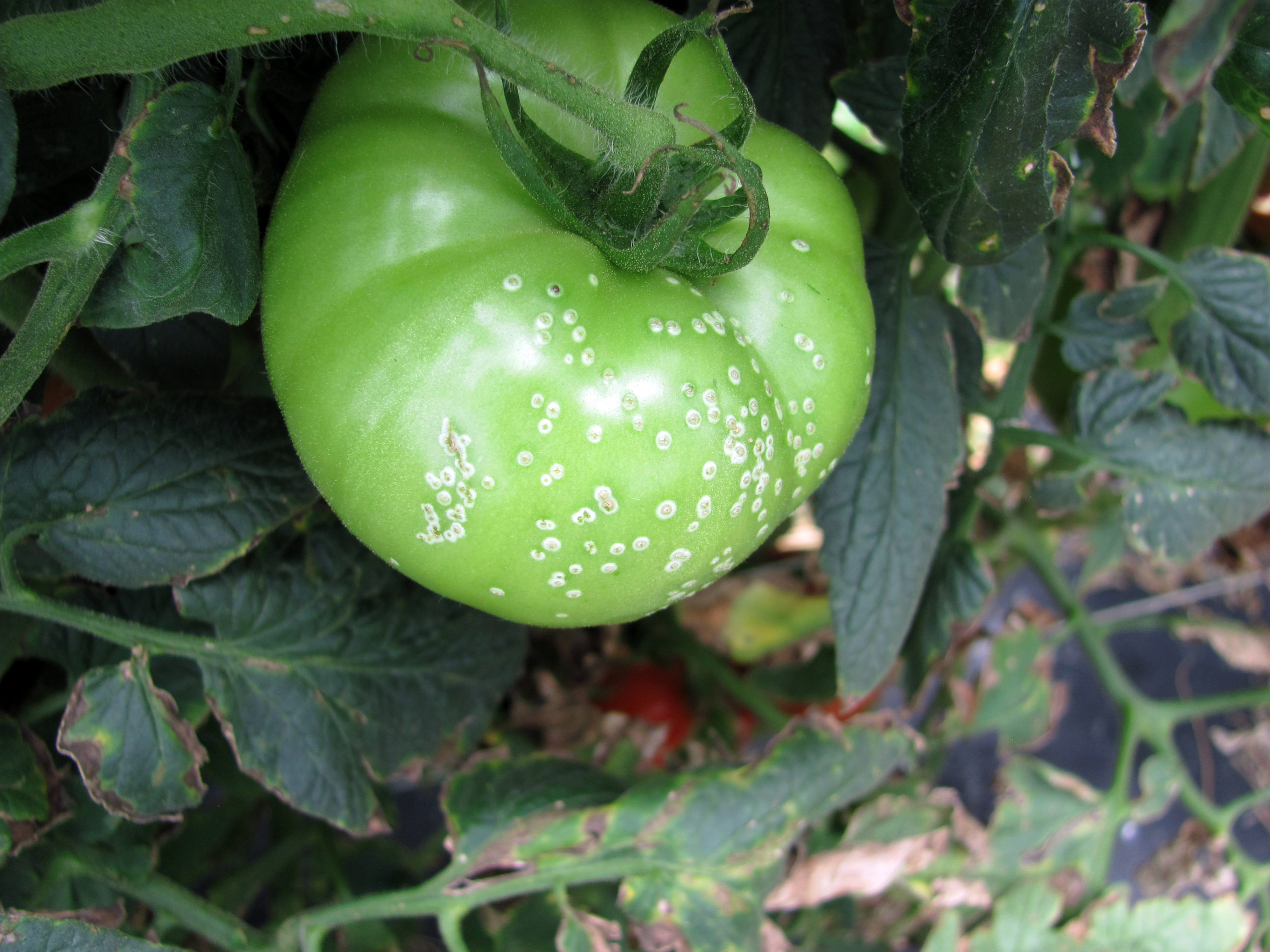
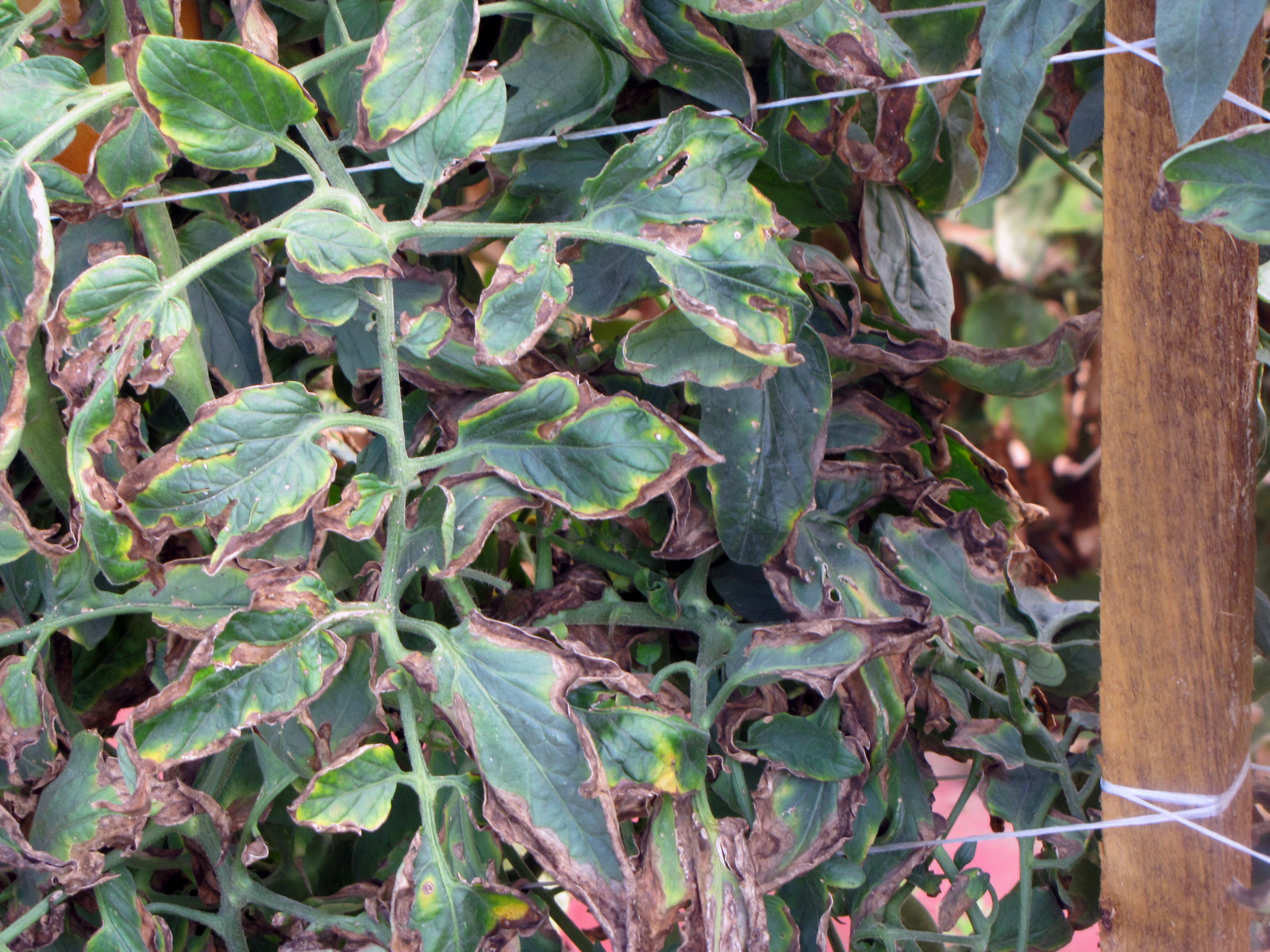
Bacterial wilt, also known as southern bacterial wilt, is caused by the bacteria Ralstonia solanacearum (previously known as Pseudomonas solanacearum). It is soilborne as well as seedborne, and develops most rapidly in hot weather (above 85°F / 30°C). The most noticeable symptom is wilting of the plants, starting with the youngest leaves and progressing down the entire plant. Cultural practices to reduce the occurrence and spread of bacterial wilt include planting resistant varieties, active scouting and removal of any diseased plants, and crop rotations that include non-susceptible plants such as rye, corn, beans, or cabbage. Infected seeds cannot be treated effectively with hot water treatment. There is currently no effective organic seed treatment for bacterial wilt.
Bacterial leaf spot is caused by multiple bacteria species in the Xanthomonas genus. It can survive on crop debris and on other hosts in the Solanaceae family. The disease progresses most rapidly when humidity is high and temperatures are between 75-86°F (24-30°C). Bacterial leaf spot begin as brown or black circular spots on the leaves that can be (but not always are) surrounded by a yellow halo. On fruit the spots appear as small brown raised blisters. Plant-to-plant transmission of up to 12 feet (4 meters) can occur in wet conditions. Cultural practices to reduce the spread of leaf spot include active scouting and removal of any diseased plants, avoiding water-based transmission by refraining from overhead irrigation, not handling tomatoes during wet conditions, removing solanaceous weeds, and practicing crop rotations. Infected seed can be effectively treated by hot water treatment.
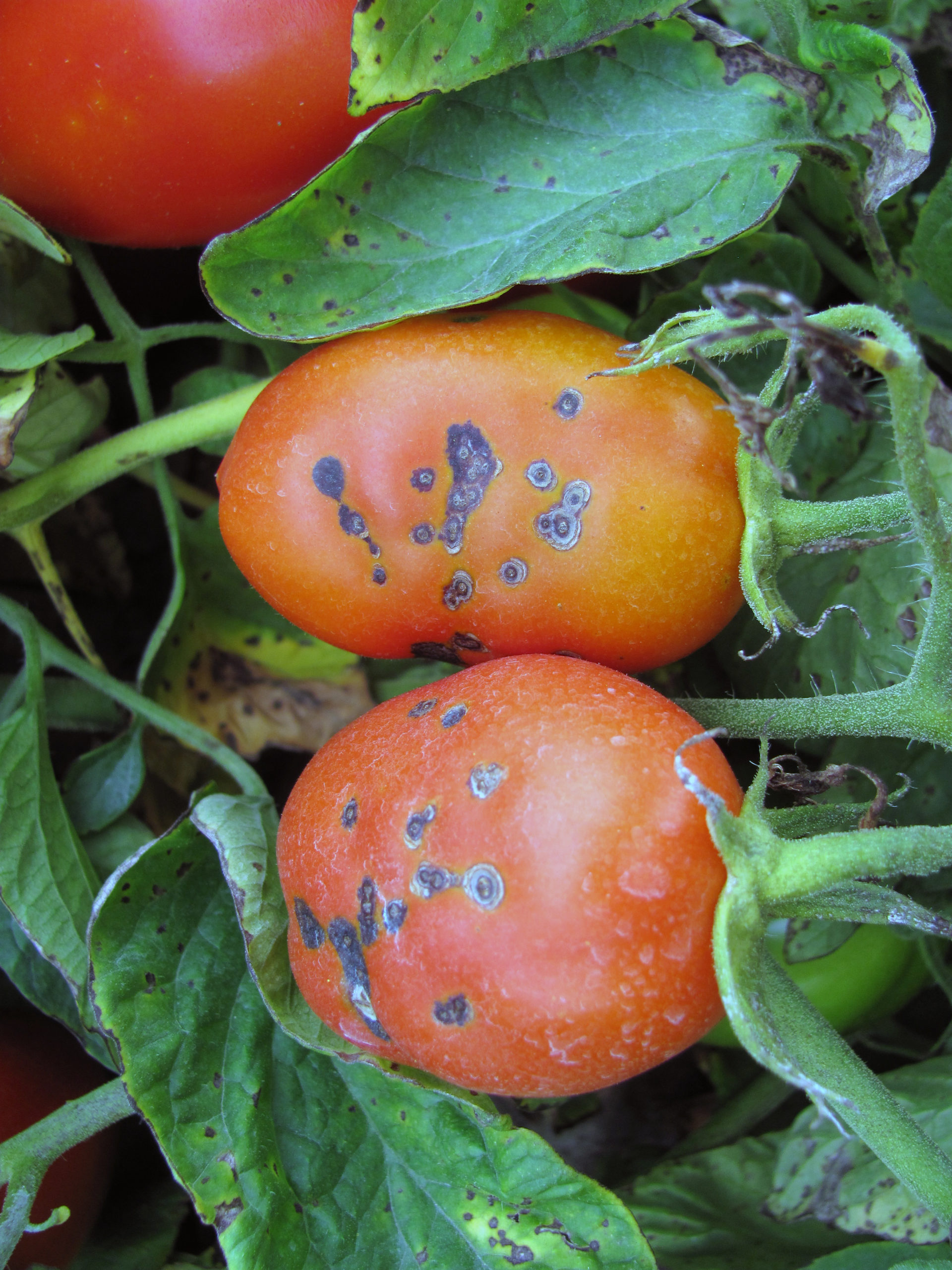
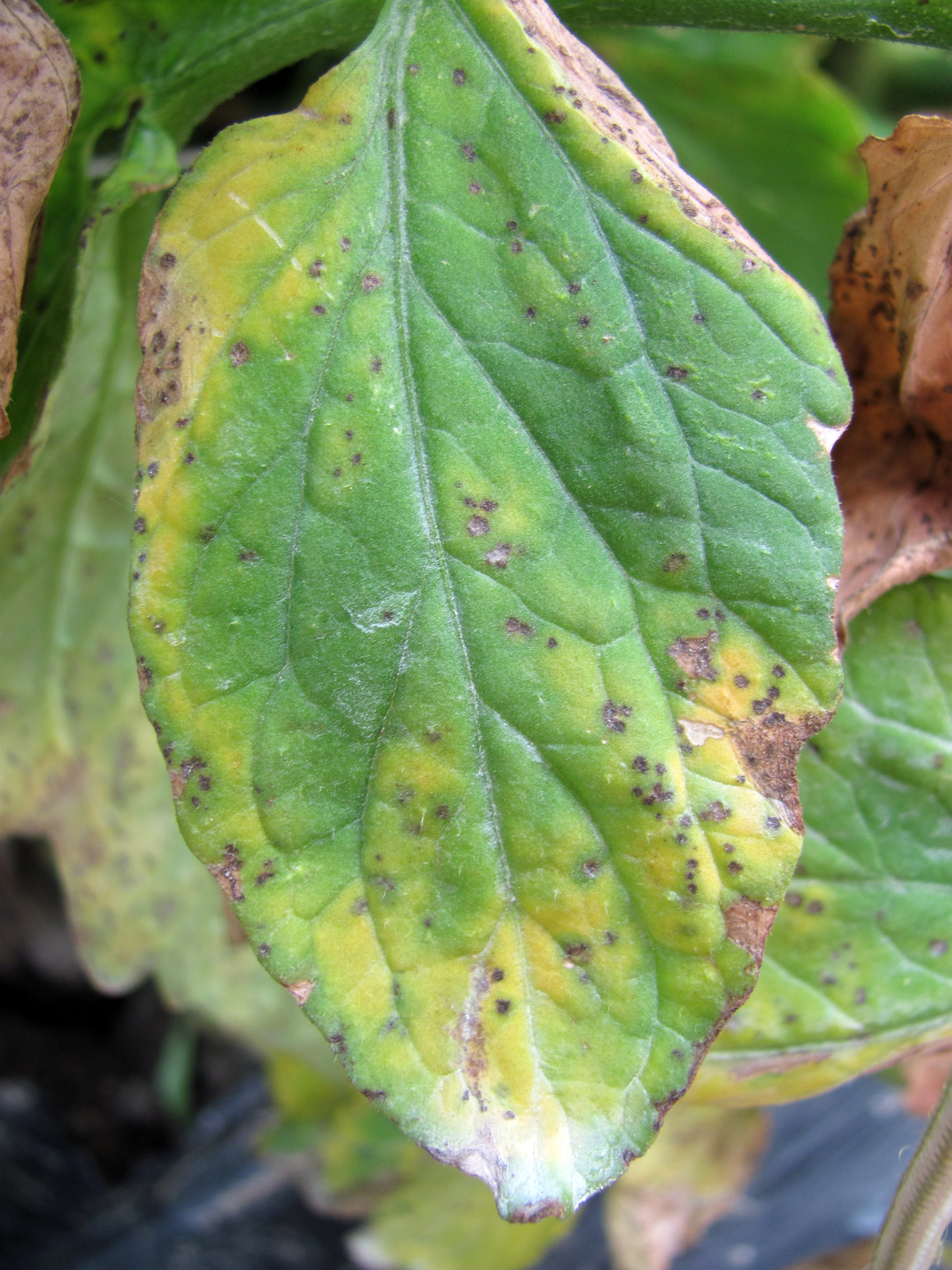
Bacterial speck and Syringae leaf spot are both caused by the bacteria Pseudomonas syringae. It can survive on crop debris. The disease progresses most rapidly when humidity is high and temperatures are cooler, around to 75°F (24°C). Syringae leaf spot can cause brown to black spots that may or may not have a yellow halo, similar to bacterial leaf spot. Bacterial speck on unripe tomato fruits appears as small black spots that are flat (not raised) and have dark green halos. Pseudomonas syringae can spread between plants during prolonged wet conditions. Cultural practices to reduce the spread of leaf spot include active scouting and removal of any diseased plants, avoiding water-based transmission by refraining from overhead irrigation, not handling tomatoes during wet conditions, and practicing crop rotations. Infected seed can be effectively treated by hot water treatment.
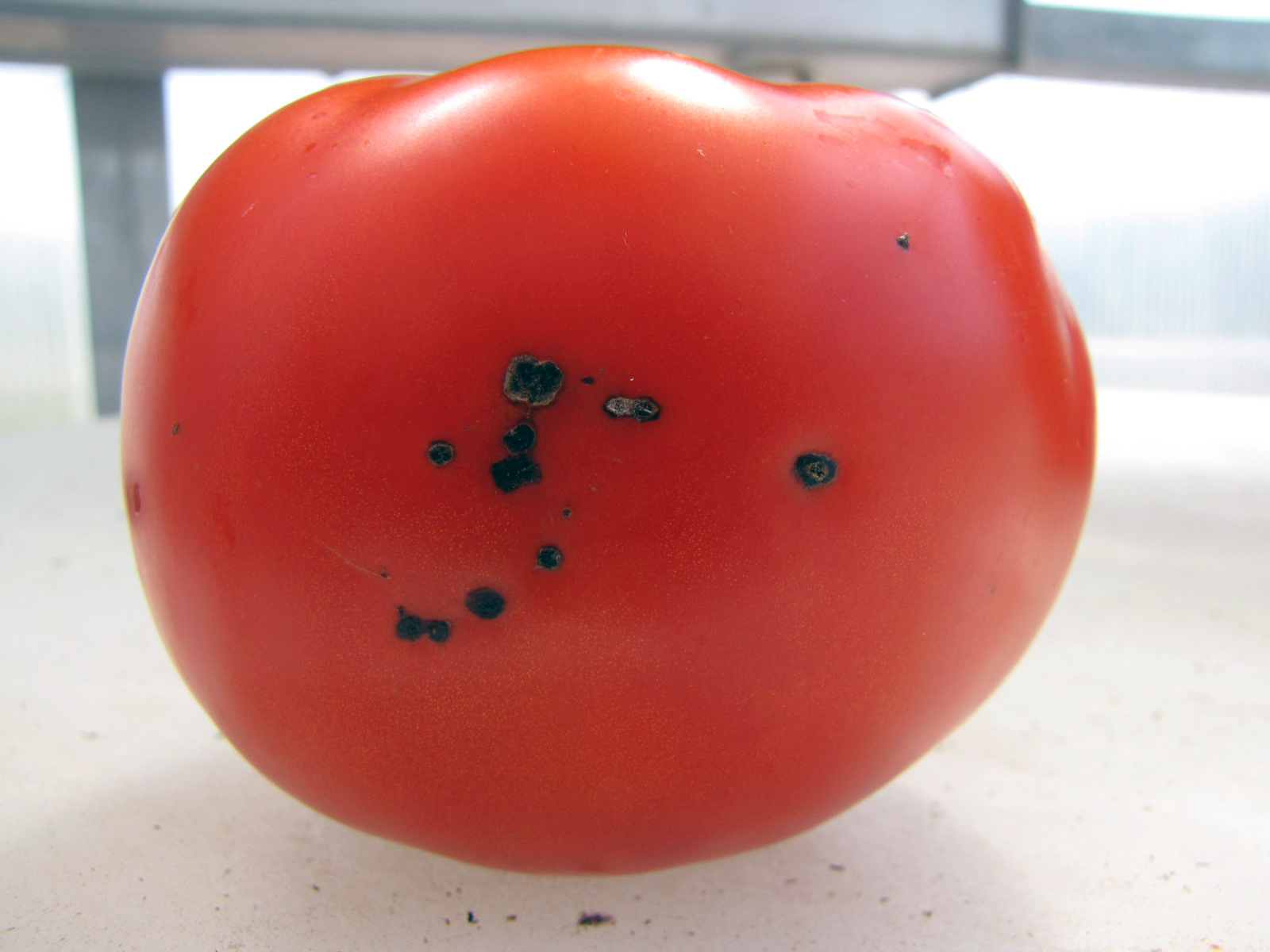
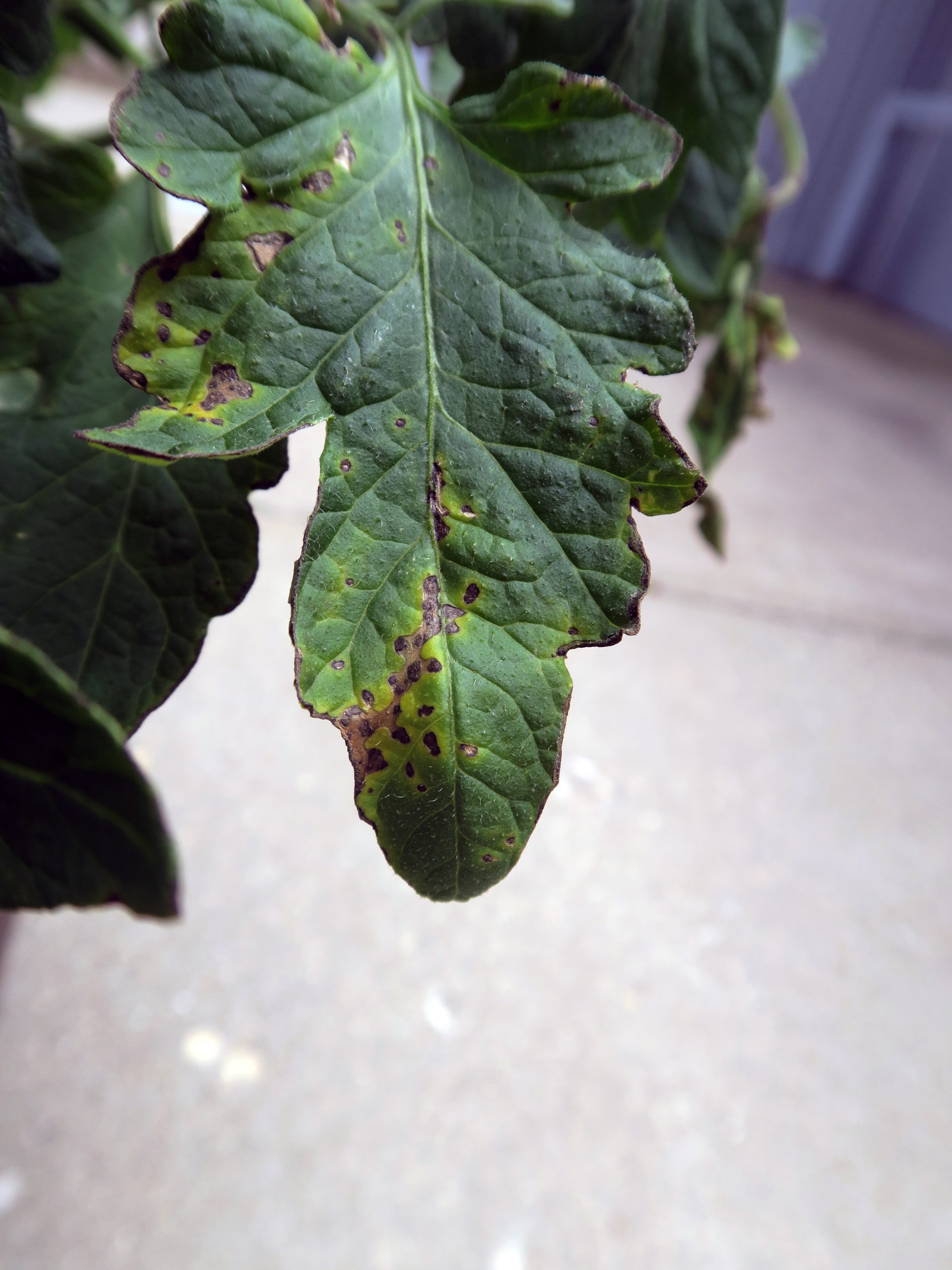
Fungal Diseases
Tomato anthracnose is caused by fungal species in the Colletotrichum genus. Temperatures around 80°F (26°C) and high humidity are most favorable for its growth. Tomato anthracnose appears on ripe fruit and small, circular, sunken spots ranging up to ½ in (1 cm) in diameter. Sclerotia, anthracnose’s reproductive structures, can survive in the soil, on seed, and on plant debris. Additionally, many weed species can serve as alternate hosts. Splashing from rain or irrigation can spread Colletotrichum between plants. Cultural practices to reduce the spread of Anthracnose include active scouting and removal of any diseased plants, keeping fields relatively clear of weeds, avoiding water-based transmission by refraining from overhead irrigation, not handling tomatoes during wet conditions, staking and pruning to increase air flow, and practicing crop rotations. Infected seed can be effectively treated by hot water treatment.
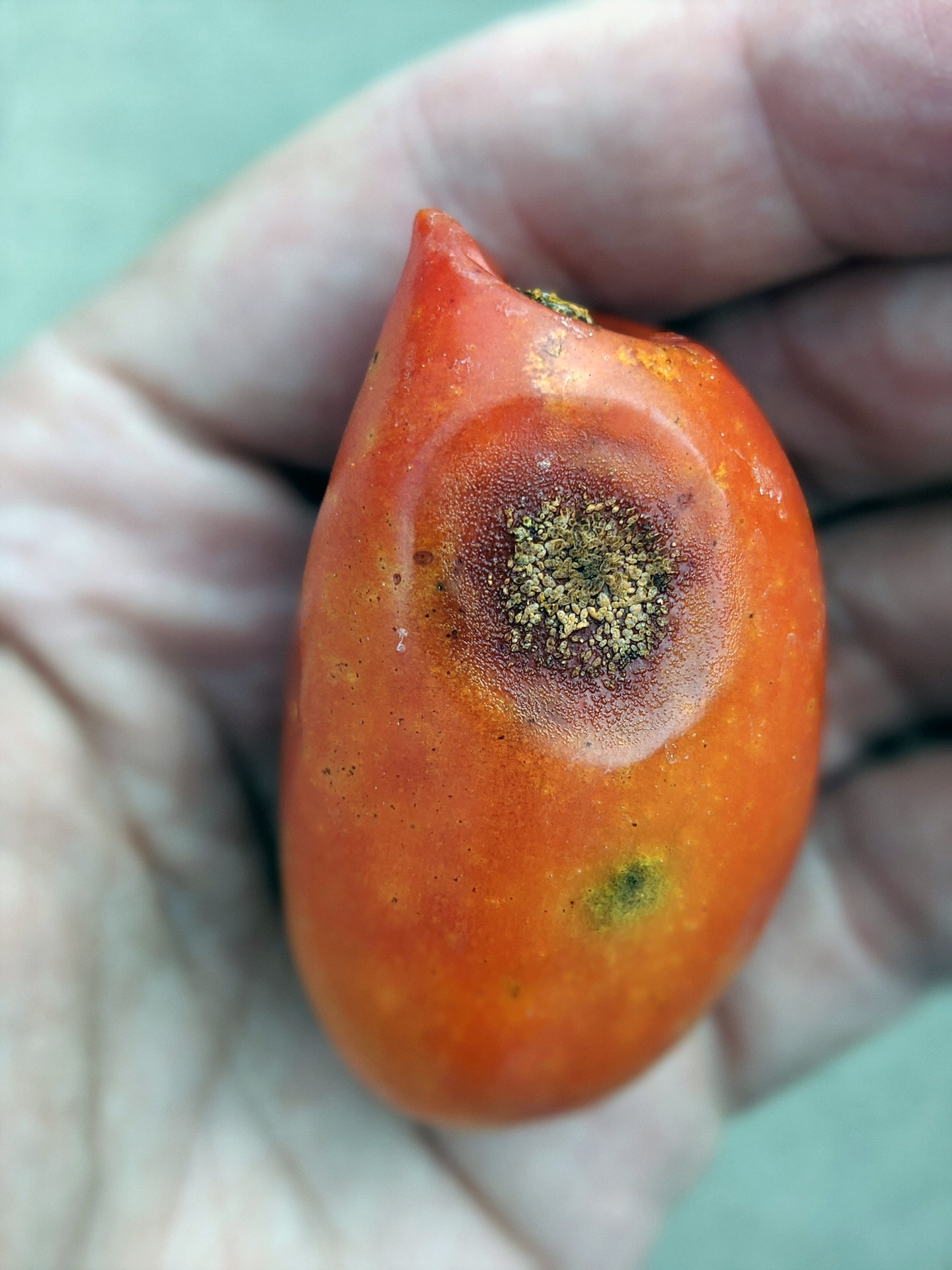
Early blight is caused by either of two fungal species Alternaria tomatophila and Alternaria solani. In addition to being seedborne, it is soilborne and can survive on crop debris and on other hosts in the Solanaceae family. Early blight can develop under high humidity and when temperatures are above 60°F (16° C), developing most rapidly at temperatures around 82-86°F (28-30°C). Symptoms of early blight can appear on tomato leaves, stems and rarely on fruit. On leaves, round brown spots will appear on the lowest leaves first, with larger spots having concentric rings. Stems nearest the ground will begin to turn brown, shrink and dry out. Early blight on fruits will appear near the stem end as leathery black spots with circular ridges. Wind, equipment and human transmission can all spread early blight between plants. Cultural practices to reduce the spread of early blight include active scouting and removal of any diseased plants, avoiding water-based transmission by refraining from overhead irrigation, not handling tomatoes during wet conditions, removing Solanaceae weeds, and practicing crop rotations. Infected seed can be effectively treated by hot water treatment.
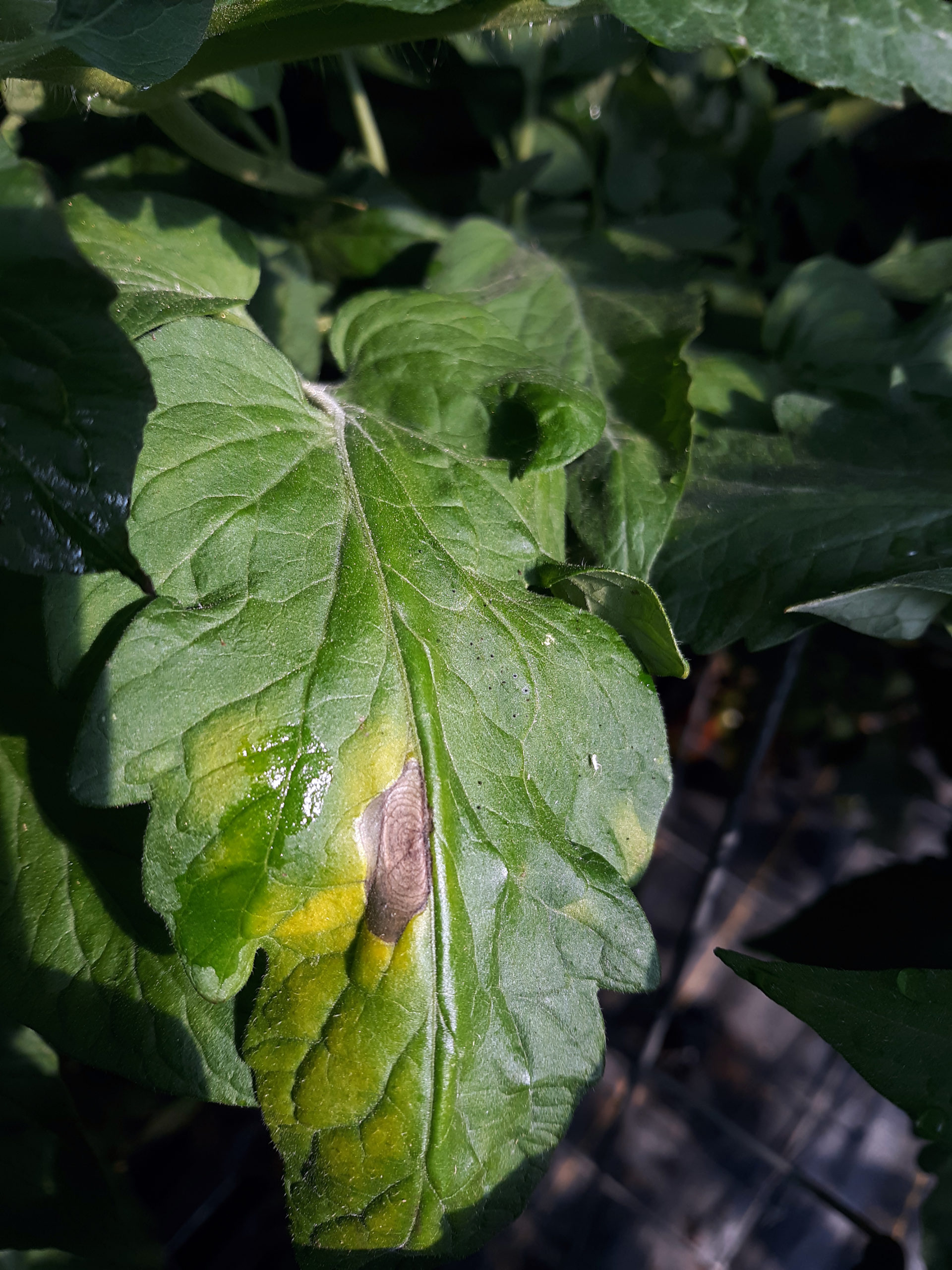
Leaf mold is caused by the fungus Passalora fulva (previously known as Fulvia fulva). In addition to being seedborne, it is soilborne and can survive on crop debris and on other hosts in the Solanaceae family. Leaf mold primarily grows in protected cultures such as high tunnels and greenhouses, where relative humidity is consistently above 85%. Symptoms appear on leaves as poorly defined pale green or yellow spots with green mold on the underside of the leaf. Cultural practices to reduce the spread of leaf mold include removing crop residues and solanaceous weeds, sanitizing the greenhouse or high tunnel between crops, staking plants and using fans to increase air flow, and maintaining warm temperatures during the night to reduce dew. Infected seed can be effectively treated by hot water treatment.
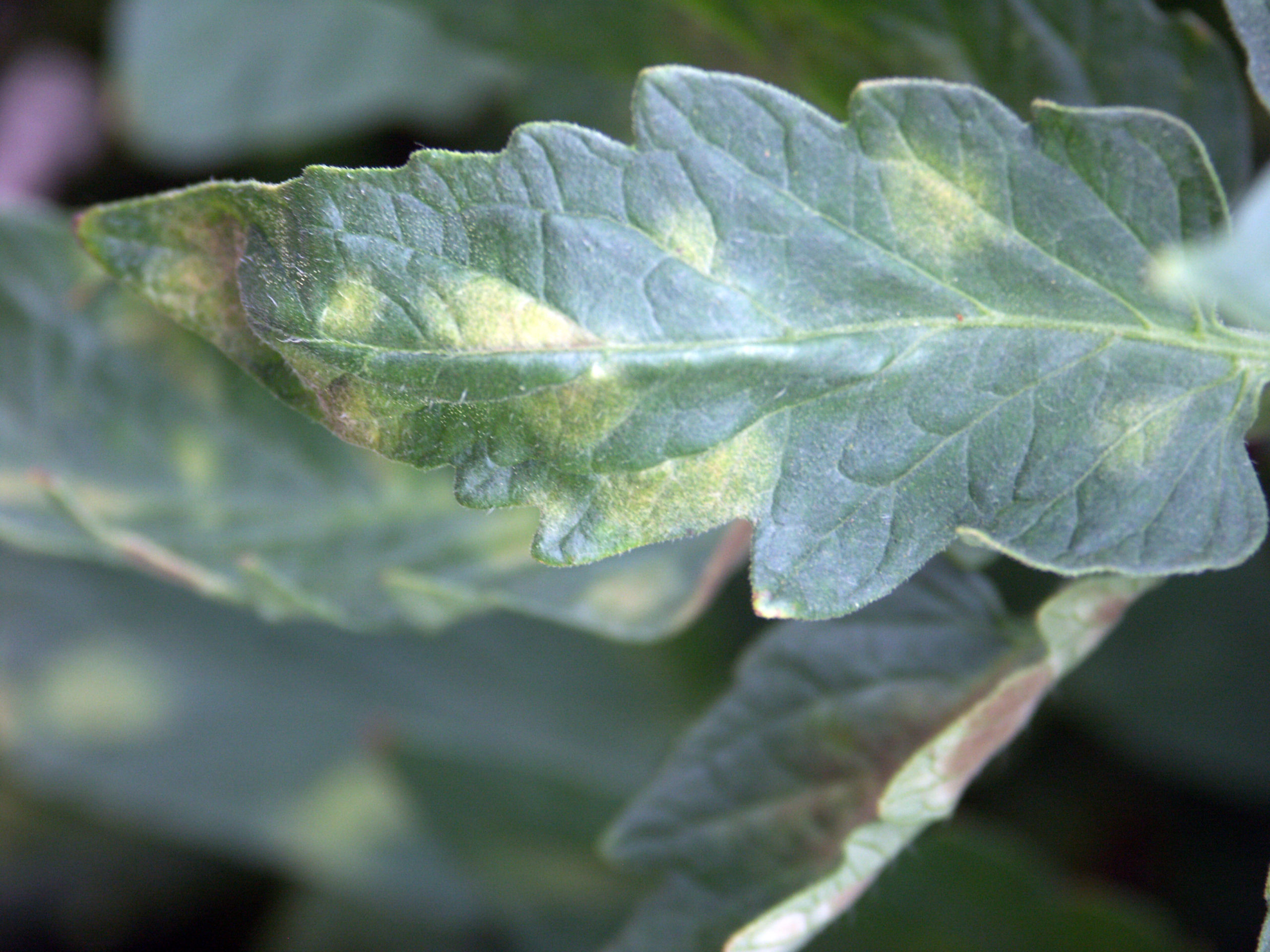
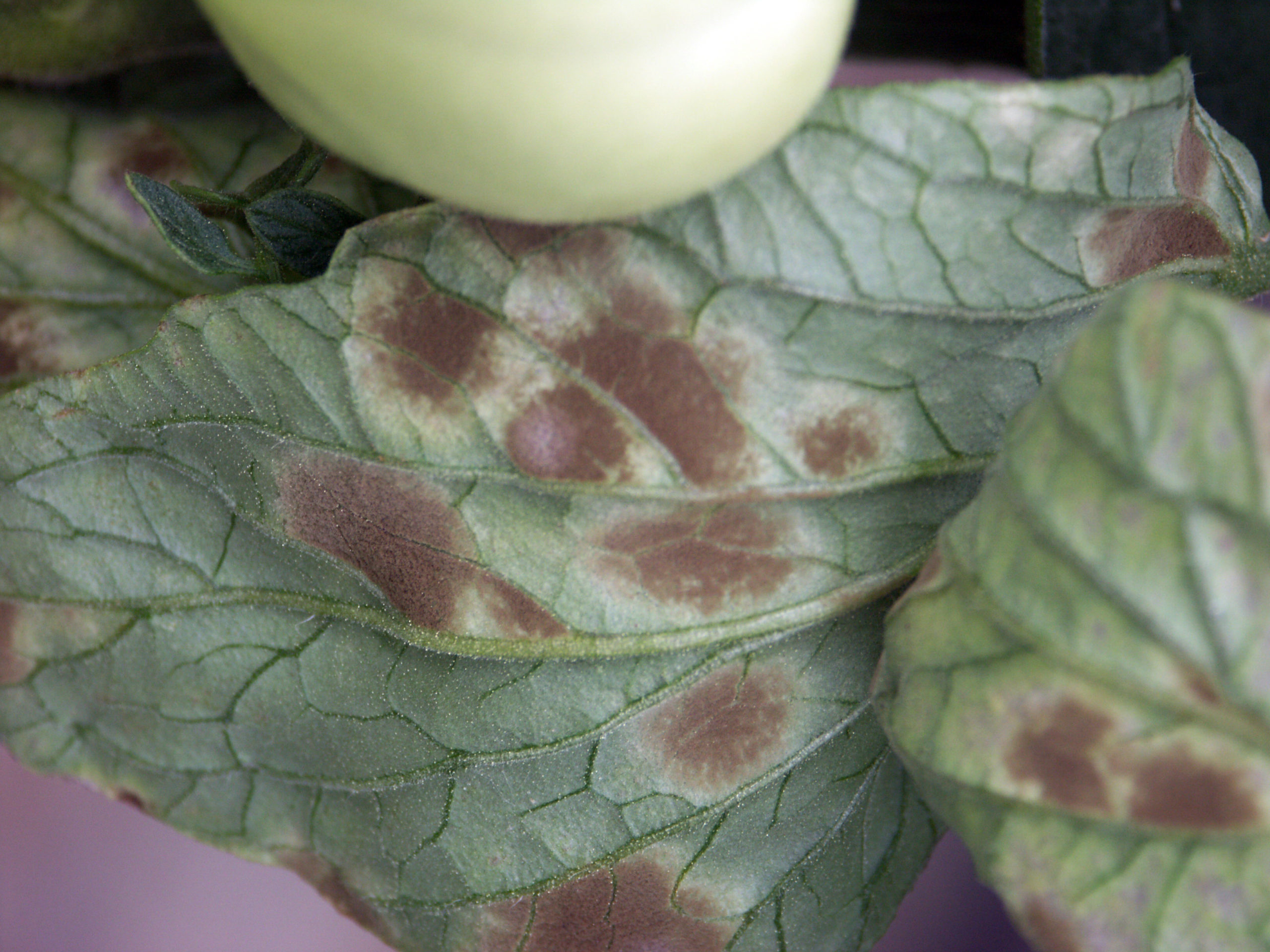
Fusarium wilt is caused by the fungus Fusarium oxysporum. In addition to being seedborne, it is soilborne and can survive on crop debris. It is seen most often in wet and acidic soils, developing most rapidly at temperatures above 82°F (28°C). Symptoms appear as wilting and yellowing leaves, often on just one side of the plant and initially just during the hottest part of the day. As the disease progresses the entire plant will eventually wilt. It will typically not spread between plants in a single growing season. Cultural practices to reduce fusarium wilt include active scouting and removal of any diseased plants, increasing the soil pH and practicing crop rotations. Infected seed can be effectively treated by hot water treatment.
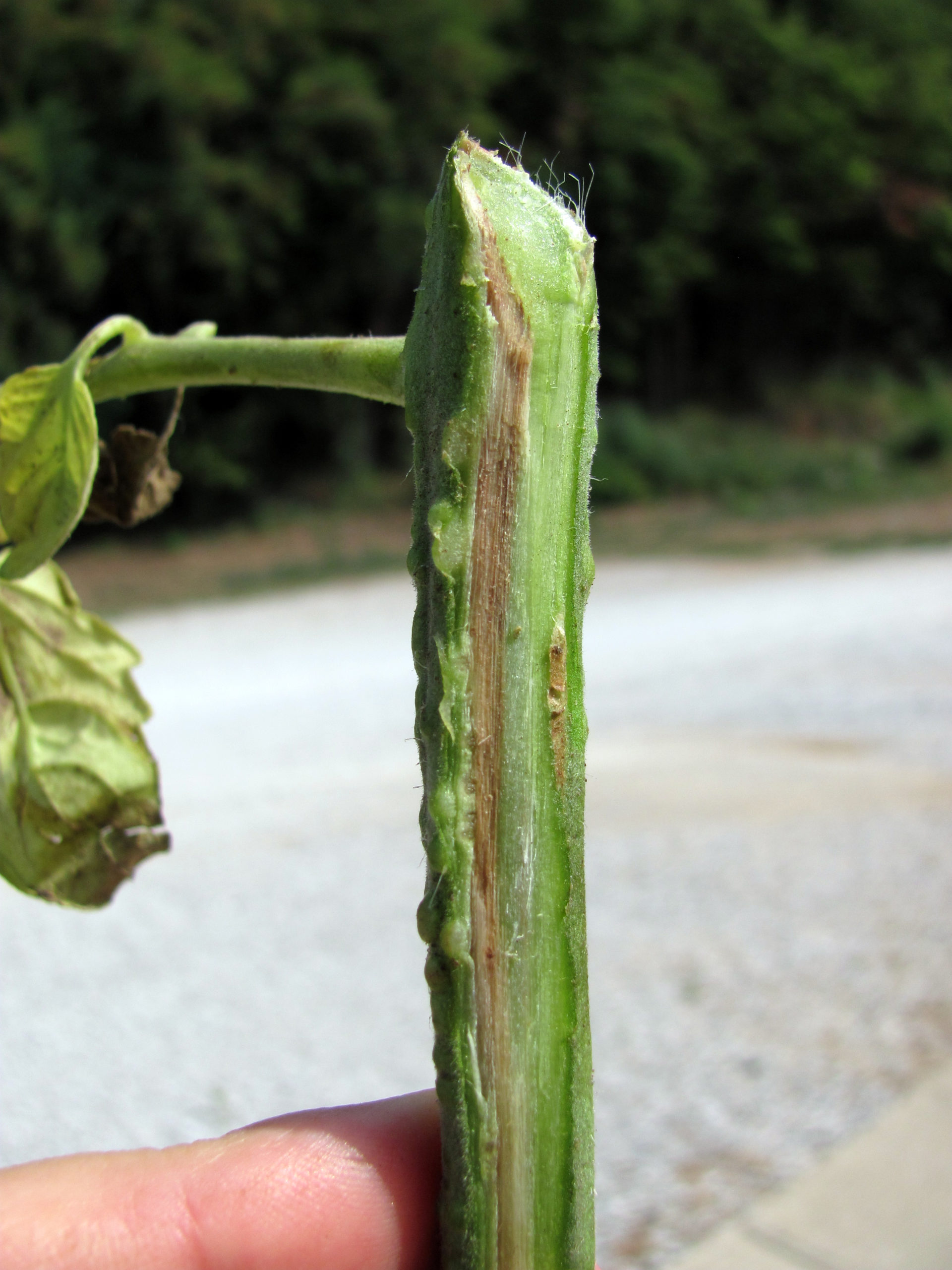
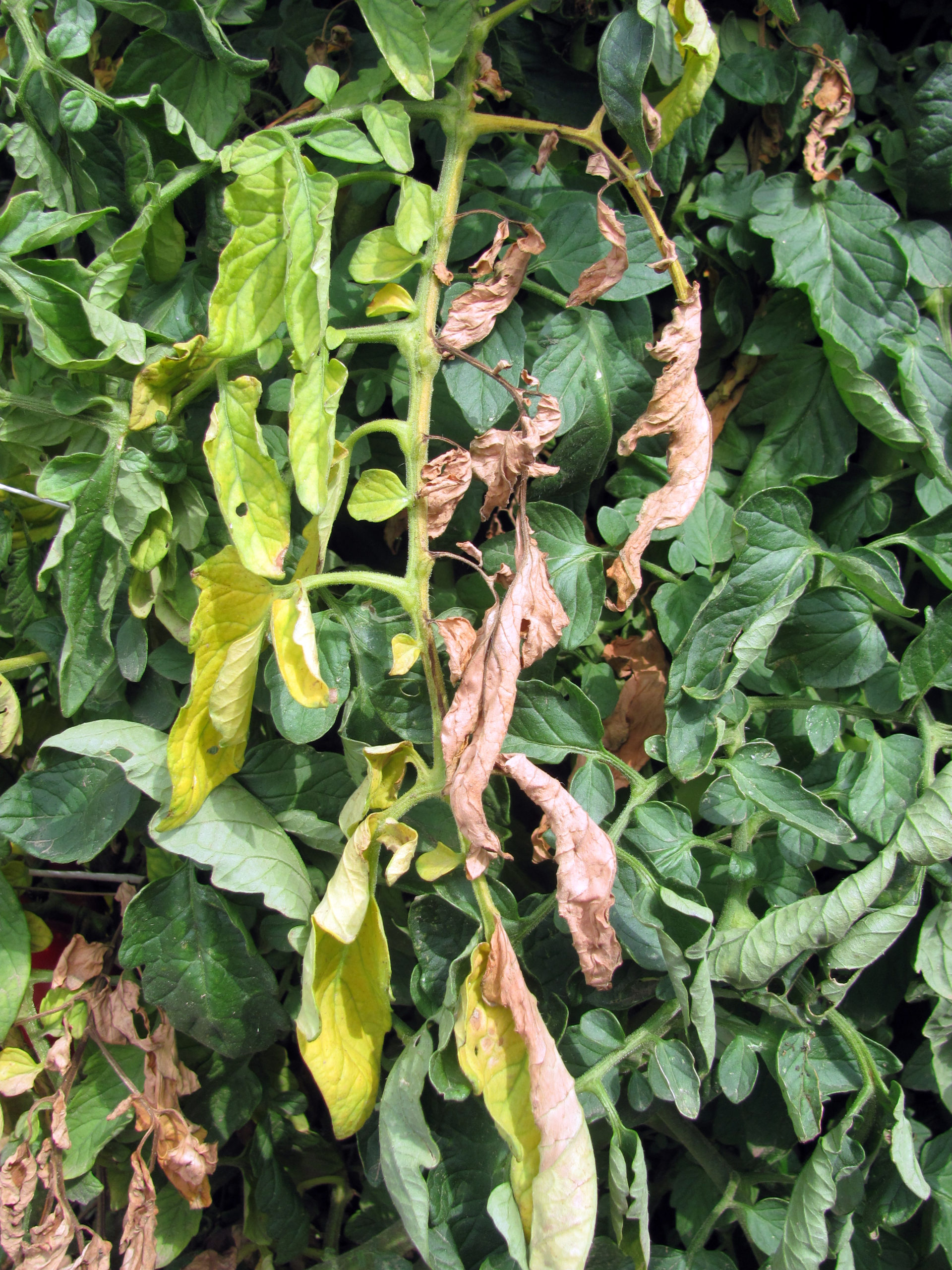
Didymella stem rot is caused by the fungus Didymella lycopersici. In addition to being seedborne, it is soilborne and can survive on crop debris and on other hosts in the Solanaceae family. It grows best in cool, wet soils, with 68°F (20°C) being optimal for disease development. Symptoms appear on the stem near ground level, initially manifesting as brown, sunken spots. As the disease progresses, the entire stem may become girdled, leading to wilting of the entire plant. Splashing from rain or irrigation can spread Didymella lycopersici between plants. Cultural practices to reduce the spread of Didymella stem rot include active scouting and removal of any diseased plants, avoiding water-based transmission by refraining from overhead irrigation, cleaning soil from equipment and supplies, not handling tomatoes during wet conditions, staking and pruning to increase air flow and prevent leaves from touching the soil, removing solanaceous weeds, and practicing crop rotations. Infected seed can be effectively treated by hot water treatment.
Phytophthora blight, also known as buckeye rot, is not technically a fungal disease, as it is caused by the oomycete Phytophthora capsici, although it does act and present in a manner similar to fungal infections. In addition to being seedborne, it is soilborne and can survive in surface water, on crop debris, and on a wide range of crop and weed hosts. It is most common in wet soils and in humid conditions with temperatures between 75-85°F (24°-29°C). The tops of plants become infected first, with wilting and the collapse of entire plants being the visible symptoms. Infected fruits have spots with a dark, water-soaked appearance, occasionally showing concentric rings. Grey or white mold may appear as the symptoms progress. Splashing from rain or irrigation can spread Phytophthora capsici between plants. Cultural practices to reduce Phytophthora blight include avoiding poorly drained fields and areas where standing water remains in a field for more than 24 hours, cleaning soil from equipment and supplies before moving from infested fields to uninfested fields, and practicing crop rotations of at least 4 years between members of the Solanaceae and Cucurbitaceae families. Infected seed can be effectively treated by hot water treatment.
Viral Diseases
Tobacco mosaic virus (TMV) and Tomato mosaic virus (ToMV) are both members of the viral genus Tobamovirus. Both TMV and ToMV can survive on dry soil and dry debris, and on a wide range of crop and weed hosts. The virus can spread at a wide range of temperature and humidity. Both diseases are very similar in appearance, with common symptoms including stunting, elongating and curling of leaves, with leaf color taking on a green and yellow “mosaic” pattern. They can spread from plant to plant by the rubbing of leaves, and by contaminated tools and hands. Cultural practices to reduce the spread of TMV and ToMV include active scouting and removal of any diseased plants and crop debris, disinfecting tools, washing hands before handling tomatoes and after handling any tobacco products, and practicing crop rotations. Infected seed can be effectively treated by hot water treatment.
Alfalfa mosaic virus (AMV) is a member of the Alfamovirus genus. AMV can survive on a wide range of hosts, including many in the Solanaceae and Fabaceae families. Leaves of infected plants develop bright yellow patches, becoming a bronze color as the disease progresses. Infected fruits will have necrotic blotches. AMV can spread via aphids (often from adjacent alfalfa fields), as well as by contaminated tools and hands. Cultural practices to reduce the spread of AMV include avoiding planting tomatoes near alfalfa fields, active scouting and removal of any diseased plants, disinfecting tools, and washing hands before handling tomatoes. Infected seed can be effectively treated by hot water treatment.
References and resources
Agrawal, K., D. Kumar Sharma, and V. Kumar Jain. 2012. Seed-borne Bacterial Diseases of Tomato (Lycopersicon Esculentum Mill.) and Their Control Measures: a Review. International Journal of Food, Agriculture and Veterinary Sciences 2 (2): 173-182 (Online.) Available at https://www.cibtech.org/J-FOOD-AGRI-VETERINARY-SCIENCES/PUBLICATIONS/2012/Vol%202%20No%202/27…Dilip….Review…Tomato.pdf (verified 1/28/21).
Amanda, S. , M. Henson and I. Meadows. 2019. Vegetable Pathology Factsheets: Bacterial Spot of Pepper and Tomato. (Online). Available at https://content.ces.ncsu.edu/bacterial-spot-of-pepper-and-tomato (verified 1/28/21).
Buttala L., J. Zystro, M. Colley S. and Siegel. 2015. The Seed Garden. Seed Savers Exchange.
Colley, M., J. Navazio and L. DiPietro. 2010. A Seed Saving Guide for Gardeners and Farmers (Online). Available at https://seedalliance.org/publications/seed-saving-guide-gardeners-farmers/ (verified 2/5/2021).
Grabowski, M. and A. Orshinsky. 2018. Bacterial canker of tomato. (Online). Available at https://extension.umn.edu/diseases/bacterial-canker-tomato (verified 1/28/21).
Gugino, B. and L. Stivers. 2018. Hot Water Treatment for Tomato and Pepper Seeds. (Online.) Available at https://extension.psu.edu/hot-water-treatment-for-tomato-and-pepper-seeds (verified 1/28/21).
Johnson A., M. Grabowski, and A. Orshinsky. 2016. Bacterial spot of tomato and pepper. (Online). Available at https://extension.umn.edu/diseases/bacterial-spot-tomato-and-pepper (verified 1/28/21).
Johnson A., M. Grabowski, and A. Orshinsky. 2015. Tomato mosaic virus and tobacco mosaic virus. (Online). Available at https://extension.umn.edu/diseases/tomato-mosaic-virus-and-tobacco-mosaic-virus (verified 1/28/21).
Johnson A., M. Grabowski, and A. Orshinsky. 2018. Early blight of tomato. (Online). Available at https://extension.umn.edu/diseases/early-blight-tomato (verified 1/28/21).
Johnson A., M. Grabowski, and A. Orshinsky. 2016. Fusarium wilt. (Online). Available at https://extension.umn.edu/diseases/fusarium-wilt (verified 1/28/21).
Maynard, D.N. and G.J. Hockmuth. 1997. Knott’s Handbook for Vegetable Growers. Wiley and Sons. New York.
McGrath, M. T. 2013. Managing Pathogens Inside Seed with Hot Water. (Online.) Available at https://www.vegetables.cornell.edu/pest-management/disease-factsheets/managing-pathogens-inside-seed-with-hot-water/ (verified 1/28/21).
McKenzie, L. 2014. How to Breed Tomatoes for Organic Agriculture. (Online). https://seedalliance.org/publications/how-to-breed-tomatoes-for-organic-agriculture/ (verified 1/28/21).
Meadows, I. 2019. Vegetable Pathology Factsheets: Early Blight of Tomato. (Online). Available at https://content.ces.ncsu.edu/early-blight-of-tomato (verified 1/28/21).
Morcote-Ríos, G., Aceituno, F.J., Iriarte, J., Robinson, M. and Chaparro-Cárdenas, J.L., 2020. Colonisation and early peopling of the Colombian Amazon during the Late Pleistocene and the Early Holocene: New evidence from La Serranía La Lindosa. Quaternary International.
Myers, J. 2021. Personal Communication.
Navazio, J., 2012. The Organic Seed Grower: A farmer’s guide to vegetable seed production. Chelsea Green Publishing.
Quesada-Ocampo L. and I. Meadows. 2019. Vegetable Pathology Factsheets: Tomato Late Blight. (Online). Available at https://content.ces.ncsu.edu/tomato-late-blight (verified 1/28/21).
Razifard, H., Ramos, A., Della Valle, A.L., Bodary, C., Goetz, E., Manser, E.J., Li, X., Zhang, L., Visa, S., Tieman, D. and van der Knaap, E., 2020. Genomic evidence for complex domestication history of the cultivated tomato in Latin America. Molecular biology and evolution, 37(4), pp.1118-1132.
Sim, S.C., Van Deynze, A., Stoffel, K., Douches, D.S., Zarka, D., Ganal, M.W., Chetelat, R.T., Hutton, S.F., Scott, J.W., Gardner, R.G. and Panthee, D.R., Mutschler M., Myers J.R., Francis D.M. 2012. High-density SNP genotyping of tomato (Solanum lycopersicum L.) reveals patterns of genetic variation due to breeding. PloS one, 7(9), p.e45520.
Disease photos courtesy Dan Egel
The Tomato Seed Production Guide is a product of the Tomato Organic Management and Improvement Project (TOMI) and was developed in partnership with project partners.
![]()






